|

|
|
RĀRANGI TAKE
AGENDA
Te Komiti Whakamauru Tūraru |
Risk and Assurance Committee Meeting
|
|
I hereby give notice that a Meeting of the Te Komiti Whakamauru Tūraru | Risk and
Assurance Committee will be held
on:
|
|
Te Rā | Date:
|
Tuesday, 11 March 2025
|
|
Te Wā | Time:
|
9.30am
|
|
Te Wāhi | Location:
|
Council
Chamber
Ground
Floor, 175 Rimu Road
Paraparaumu
|
|
Mark de Haast
Group Manager Corporate Services
|
|
Risk and Assurance Committee Meeting Agenda
|
11 March 2025
|
Kāpiti Coast District Council
Notice is hereby given
that a meeting of the Te Komiti
Whakamauru Tūraru | Risk and Assurance Committee will be held in the Council Chamber, Ground Floor, 175 Rimu Road,
Paraparaumu, on Tuesday 11 March 2025, 9.30am.
Te Komiti Whakamauru
Tūraru | Risk and Assurance Committee Members
|
Mr
David Shand
|
Chair
|
|
Mayor
Janet Holborow
|
Member
|
|
Deputy
Mayor Lawrence Kirby
|
Member
|
|
Cr
Liz Koh
|
Member
|
|
Cr
Jocelyn Prvanov
|
Member
|
|
Cr
Glen Cooper
|
Member
|
|
Mr
David Cochrane
|
Member
|
|
Risk and Assurance Committee Meeting Agenda
|
11 March 2025
|
8 He
Kōrero Hou | Updates
8.1 Emergency
Management Update
Kaituhi |
Author: Roddy
Hickling, Manager Emergency Management
Kaiwhakamana
| Authoriser: Sean Mallon, Group Manager Infrastructure and
Asset Management
Te pūtake |
Purpose
1 This
report provides the Risk and Assurance Committee with key findings from the
Wellington Region Emergency Management Office (WREMO) annual capability
assessment of the emergency management system delivered by Kāpiti Coast
District Council (KCDC), as well as the Rū Whenua a Rohe Evaluation
Report.
2 These
findings will inform governance on the current state of emergency preparedness,
highlight areas for improvement, and shape the focus of the 2025 work program
to enhance the district’s ability to respond and recover from
emergencies.
Taunakitanga | RECOMMENDATIONS
A. That
the Risk and Assurance Committee notes this update.
Tūāpapa | Background
3 Under
the CDEM Act (2002) local authorities have a responsibility to ensure that the
district is able to function to the fullest extent possible, even though this
may be at a reduced level during and after an emergency, and to plan and
provide for civil defence emergency management within their District.
4 In
recent years, there has been an increase in frequency and severity of weather
events. There is a critical need to be able to respond and then recover
effectively from such events at the same time as preparing for lower frequency
but higher impact events like a major earthquake and/or tsunami.
5 This
is the first time a capability assessment of this kind has been conducted for
KCDC. It provides an evidence-based understanding of the current state of
emergency management and will guide future resource allocation,
decision-making, and operational improvements.
6 Together
with the Ru Whenua a Rohe exercise evaluation, the assessment has identified
key areas of strength and areas requiring improvement, which have been
incorporated into the 2025 work program.
He take |
issues
7 No
issues noted.
Ngā
kōwhiringa | Options
8 No
options noted.
ngā Mahi
panuku |
next steps
9 The
Risk and Assurance Committee is requested to note and support these
initiatives as part of KCDC’s ongoing efforts to strengthen
emergency preparedness and response.
Ngā āpitihanga | Attachments
1. Emergency
Management Update ⇩ 
|
Risk and Assurance Committee Meeting Agenda
|
11 March 2025
|













|
Risk and Assurance Committee Meeting Agenda
|
11 March 2025
|
9 Pūrongo
| Reports
9.1 Ernst
& Young Audit Plan for the year ended 30 June 2025
Kaituhi |
Author: Michael
Parrish, Manager, Financial Accounting
Kaiwhakamana
| Authoriser: Mark de Haast, Group Manager Corporate Services
Te pūtake |
Purpose
1 This
report provides the Risk and Assurance Committee with Ernst & Young’s
Audit Plan, on behalf of the Office of the Auditor General (OAG), for the year
ending 30 June 2025.
He
whakarāpopoto | EXecutive summary
2 Not
required.
Te tuku haepapa
| Delegation
3 Risk
and Assurance Committee has delegated authority to consider this report under
section C.3 of the Governance Structure and Delegations.
· Obtaining
from external auditors any information relevant to the Council’s
financial statements and assessing whether appropriate
action has been taken by management in response to the above.
Taunakitanga | RECOMMENDATIONS
A. That
the Risk and Assurance Committee receives and notes the Ernst & Young Audit
Plan for the year ending 30 June 2025 attached as Appendix 1 to this
report.
Tūāpapa | Background
4 The
Council’s Auditors, Ernst & Young (Audit), have been engaged to
undertake the audit of the Council’s Annual Report and Summary Annual
Report along with compliance with its Debenture Trust Deed, for the year ended
30 June 2025.
5 The
Audit Plan is attached as Appendix 1 to this report. This provides an
overview of Audit’s focus areas, their risk assessment and their audit
approach for the year ended 30 June 2025.
He
kōrerorero | Discussion
6 The
areas of audit focus are summarised below:
· Property,
Plant and Equipment
· Rates
setting, invoicing and collection
· Non-financial
performance reporting
· Expenditure,
procurement and tendering
· Debt
facilities and derivatives
· Revenue
from grants and subsidies.
Materiality
7 Audit
has set their materiality threshold at $4.0 million, being 3% of forecast
expenditure for 2024/25. Materiality is broadly defined as the quantum of any
misstatements (through error or otherwise), that would likely mislead users of
the financial statements. Any identified misstatements impacting on the
Council’s operating result by more than $198,000 will be reported to the
Committee by way of Audit’s Closing Report on conclusion of their audit
He
take | Issues
8 This
matter has a low level of significance under the Council’s Significance
and Engagement Policy.
Ngā
kōwhiringa | Options
9 There
are no options to consider.
Mana whenua
10 There
are no mana whenua considerations arising from this report.
Panonitanga Āhuarangi me te Taiao | Climate change
and Environment
11 There
are no climate change considerations within this report.
Ahumoni me ngā rawa | Financial
and resourcing
12 As
disclosed in the audit proposal letter dated 27 June 2023, the fees for the
period ending 30 June 2025 will equate to $255,000. This is before any
estimated disbursements and is exclusive of GST.
Tūraru ā-Ture me te Whakahaere
| Legal and Organisational Risk
13 There
are no legal and organisational risk arising from this report.
Ngā pānga ki ngā kaupapa here | Policy impact
14 There
are no policy implications arising from this report.
TE whakawhiti kōrero me te
tūhono | Communications &
engagement
Te mahere tūhono | Engagement
planning
15 An
engagement plan is not required for this report.
Whakatairanga |
Publicity
16 There
are no specific publicity considerations arising from this report.
Ngā āpitihanga | Attachments
1. Ernst
& Young Audit Plan for the year ending 30 June 2025 ⇩ 
|
Risk and Assurance Committee Meeting Agenda
|
11 March 2025
|

















|
Risk and Assurance Committee Meeting Agenda
|
11 March 2025
|
9.2 Ernst &
Young Control Findings - Progress Update
Kaituhi |
Author: Sharon
Foss, Manager Risk and Assurance
Kaiwhakamana
| Authoriser: Sheryl Gavin, Acting Group Manager Corporate
Services
Te pūtake |
Purpose
1 This
report outlines how audit matters raised as control findings from Ernst and
Young (EY) relating to the Annual Report 2023-24 and
the corporate planning process for the 2024-34 Long Term Plan will be
addressed.
He
whakarāpopoto | Executive summary
2 Not
required.
Te tuku haepapa
| Delegation
3 The
Risk and Assurance Committee is authorised to consider this matter according to
section C.3 of the Governance Structure and Delegations for the 2022-2025
triennium which state the committee has the delegation to:
· Review
and maintain the internal control framework
· Obtain from
external auditors any information relevant to Council’s financial
statements and assess whether appropriate action has been taken by management
in response to the above.
Taunakitanga | RECOMMENDATIONS
A.1 That
the Risk and Assurance Committee receives this report and notes the work
programme to address the Ernst & Young control findings for the Annual Report 2023-24 and the corporate planning
process for the 2024-34 Long Term Plan.
Tūāpapa | Background
4 EY,
our external auditors, review our key financial and corporate reporting
processes. They audited the Annual Report for the year ending 30 June 2024 and
reviewed the Long-Term Plan 2024-34 and
Consultation Document development process. While each review shares the same
risk ranking reference, e.g. ‘moderate’, EY have applied different
descriptives against each rank. The control findings across both reviews have
been accepted by this Committee as corrective measures to strengthen the
Council corporate planning process.
He
kōrerorero | Discussion
5 The
EY Annual Report management letter lists four control findings, one ranked
moderate risk and three as low risk. EY will review these in the 2024/25 audit
to see if they can be closed.
6 The EY Long-term Plan management letter lists six findings
highlighting weaknesses in our controls. Three are ranked as moderate risk and
three as low risk. Key areas for improvement include the forecasting model, the
consultation document development process, Long-term Plan content, and other
significant matters for future planning.
7 The Group Manager Corporate Services will report progress
updates on EY’s 10 control findings to this Committee and these will be
reviewed by EY during the 2024-25 audit. Commentary on each control finding and
progress is provided in Appendix 1 to this report.
8 Summary of year-to-date progress is shown in the tables
below
|
Risk
|
EY #
|
Part A
– Annual Report Control Findings
|
Status: Feb 2025
|
|
Moderate
|
2.1.1
|
Accuracy of response
and resolution times
|

|
In
Progress
|
|
Low
|
2.2.1
|
Aged work in progress review
|

|
In Progress
|
|
Low
|
2.2.2
|
Overhead rate applied to projects.
|

|
In Progress
|
|
Low
|
2.2.3
|
Approval of expenditure
|

|
In Progress
|
|
Risk
|
EY #
|
Part B – LTP 2024-34 Control Findings
|
Status: Feb 2025
|
|
Moderate
|
2.1.1
|
Overall
project management and timeline
|

|
In
Progress
|
|
Moderate
|
2.1.2
|
Identifying
consultation issues, developing the right debate, and the readability of the
consultation document
|

|
In
Progress
|
|
Moderate
|
2.1.3
|
Development
of the Infrastructure Strategy and Financial Strategy
|

|
In Progress
|
|
Low
|
2.2.1
|
Approach
to financial modelling
|

|
In Progress
|
|
Low
|
2.2.2
|
Development
and peer review of asset management plans and ensuring alignment with key
strategies and policies
|

|
In Progress
|
|
Low
|
2.2.3
|
Key capital project cost assessment and estimation
|

|
In Progress
|
He
take | Issues
9 There are no additional issues arising from this report.
Ngā
kōwhiringa | Options
10 There
are no options arising from this report.
Mana whenua
11 There
are no tangata whenua considerations arising from this report and mana whenua
have not been consulted in relation to this report – as it is procedural.
Panonitanga Āhuarangi me te Taiao | Climate change
and Environment
12 There
are no climate change issues arising from this report.
Ahumoni me ngā rawa | Financial
and resourcing
13 There are no financial
considerations in addition to those already discussed in this report.
Tūraru ā-Ture me te Whakahaere
| Legal and Organisational Risk
14 There
are no legal or risk issues from this report. The control findings are
corrective measures to strengthen the Council’s corporate planning
processes. None of the findings are considered high risk.
Ngā pānga ki ngā kaupapa here | Policy impact
15 There
are no policy implications in relation to this report.
Te whakawhiti
kōrero me te tūhono | Communications & engagement
Te mahere tūhono | Engagement
planning
16 This
matter has a low level of significance under the Council’s Significance
and Engagement Policy and no engagement is triggered.
Whakatairanga |
Publicity
17 This
report and appendices will be publicly available through the agenda for the
Risk and Assurance Committee meeting.
Ngā āpitihanga | Attachments
1. Appendix
1 - Control Findings ⇩ 
|
Risk and Assurance Committee Meeting Agenda
|
11 March 2025
|



|
Risk and Assurance Committee Meeting Agenda
|
11 March 2025
|
9.3 FY2024-25
Quarter 2, - Workplace Health, Safety and Wellbeing
Kaituhi |
Author: Kelly
Newbold, Manager Health Safety and Wellbeing
Kaiwhakamana
| Authoriser: Rach Wells, Group Manager People and Capability
Te pūtake |
Purpose
1 This
report presents the Workplace Health, Safety and Wellbeing report for the
period 1 October to 31 December 2024.
He
whakarāpopoto | EXecutive summary
2 Not
required for this report.
Te tuku haepapa
| Delegation
3 The
Risk and Assurance Committee has delegated authority to consider this report
under the following delegation in the Governance Structure, Section C 1.
o Ensuring
that the Council has in place a current and comprehensive risk management
framework and making recommendations to the Council on risk mitigations,
o Assisting
Elected Members in the discharge of their responsibilities by ensuring
compliance procedures are in place for all statutory requirements relating to
their role,
o Governance
role in regard to the Health, Safety and Wellbeing Policy and Plan.
Taunakitanga | RECOMMENDATIONS
A. That
the Risk and Assurance Committee notes the Health and Safety Quarterly Insights
Report for the period 1 October to 31 December 2024, attached as Appendix One
to this Report.
Tūāpapa | Background
4 The
quarterly Health, Safety and Wellbeing Report is intended to provide the
Council with insights into initiatives and activities and their progress, as
part of the Council’s commitment to providing a safe and healthy place to
work. The contents and any subsequent discussions arising from this report can
support Officers to meet their due diligence obligations under the Health and
Safety at Work Act (HSWA) 2015.
5 The
timing of the Health and Safety Quarterly Reports does not prevent an ‘as
and when required’ verbal update from the Chief Executive to the Mayor
and Council regarding serious or high-profile risk events. Such events would be
recorded and retrospectively included in the next available Quarterly Report.
He
kōrerorero | Discussion
6 This
report provides a summary update on the Health, Safety and Wellbeing
activities, and initiatives that are underway or planned to be undertaken
during the 2024/2025 financial year, across policies, risk review, audits and
assessments.
He
take | Issues
7 There
are no issues arising from this report.
Ngā
kōwhiringa | Options
8 There
are no options arising from this report.
Mana whenua
9 There
are no mana whenua considerations arising from this report.
Panonitanga Āhuarangi me te Taiao | Climate change
and Environment
10 There
are no climate change considerations arising from this report.
Ahumoni me ngā rawa | Financial
and resourcing
11 There
are no financial or resourcing considerations arising from this report.
Tūraru ā-Ture me te Whakahaere
| Legal and Organisational Risk
12 There
are no legal or organisational risks in addition to those noted in this report.
Ngā pānga ki ngā kaupapa here | Policy impact
13 There
are 13 Health, Safety and Wellbeing related policies that are either under
review or due to be reviewed in this financial year. Minor progress was planned
during Q2 on these reviews due to resourcing constraints, reviews recommence in
Q3. The review status is detailed in the below table.
|
Policy Name
|
Policy
Description
|
Policy Review
Due Date
|
Review Status
|
|
Corporate Policy
Statement - Health and Safety
|
Statement from
CEO to outlining Council's approach to H&S and expectations.
|
N/A
|
Implementation
stage
|
|
HR-21
Contractors Health and Safety Management
|
To set Council
expectations of Contractors working on Council sites.
|
Jan 2025
|
In
progress
|
|
HR-13-020 Health
and Safety
|
Outlines
Council's approach to managing H&S
|
Feb 2022
|
In
progress
|
|
HR-13-018 Hazard
Management
|
Aims to ensure
the safety of Council employees, visitors and contractors required to
work on or around its premises.
|
|
To be revoked
when HR-13-020 H&S Policy Review Complete
|
|
HR-13-022
Working Alone or in Isolation
|
Outlines the
H&S responsibilities of the Council, its managers and workers. It applies
to those who may be required to work alone or in remote.
|
May 2020
|
|
HR-24 Personal
Protective Equipment
|
To ensure the
provision of PPE where required to minimise the risk of harm.
|
2 year review
cycle
|
|
HR-030 Incident
and Accident Management
|
To ensure all
safety information about accidents, incidents, and near-misses are reported
and investigated appropriately
|
Nov 2019
|
|
HR-13-024 Smoke
Free Workplace
|
To provide a
smokefree environment that will assist to improve the health status of all
those who undertake work for or visit Council workplaces.
|
Dec 2021
|
|
HR-16-034 Care
Register
|
Sets out the guidelines
and parameters for the use, maintenance and review of the Care Register.
|
July 2020
|
Planned Q3
|
|
HR-16-035
Visitors
|
To ensure a safe
environment for visitors at a Council workplace so they remain safe from harm
or risk during that visit.
|
Dec 2021
|
Planned Q4
|
|
HR-16-044
Preventing and Responding to Workplace Bullying
|
To provide
guidance for how to identify, report, address, and help prevent worplace
bullying and other undesirable behaviour in our workplace.
|
Dec 2021
|
Planned Q3
|
|
HR-18 Return to Work
|
Aims to ensure
good communication is established and maintained betrween the Council,
employee, treatment provider, and ACC to faciliate a RTW programme
|
April 2011
|
Planned Q3
|
|
HR-13-015
Rehabilitation Management
|
Aims to ensure
the early, safe and lasting return to work of Council employees following
injury or illness.
|
May 2019
|
Planned Q4
|
|
HR-13-017 Staff
Wellness
|
Provides
information regarding the broad range of wellness initiatives offered to
employees, encompassing both emotional and physical wellbeing.
|
Dec 2018
|
Planned Q3
|
|
HR-19 Vehicle
User
|
To clarify the
responsibilities of drivers when using Council vehaicles, ensourage and
promote safe driving behaviours.
|
Feb 2023
|
Planned Q4
|
|
HR-19-041
Alcohol in the Workplace
|
Provides guidance
for supplying and consuming alcohol at social events in Council workplaces or
at Council-owned or controlled facilities.
|
May 2024
|
Planned Q4
|
|
HR-26 Drug and
Alcohol
|
To ensure that
all workers can work in an environment free of alcohol and drug use or abuse.
|
Mar 2021
|
Planned Q4
|
|
HR-13-016
Emergency Preparedness
|
To ensure
Council has effective emergency plan to manage emergencies likely to occur
across Council worksites.
|
Dec 2018
|
|
|
HR-16 - Flexible
Working Arrangements (FWA)
|
Policy to
provide the process for flexible working arrangements including change in
hours and location.
|
April 2019
|
In
progress
|
TE whakawhiti kōrero me te
tūhono | Communications &
engagement
14 Health,
Safety and Wellbeing internal communication continues to increase through a
range of internal channels.
Te mahere tūhono | Engagement
planning
15 An
engagement plan is not needed regarding this report.
Whakatairanga |
Publicity
16 There
are no publicity considerations regarding this report.
Ngā āpitihanga | attachments
Ngā āpitihanga | Attachments
1. Insights
Report for the period 1 October to 31 December 2024 ⇩ 
|
Risk and Assurance Committee Meeting Agenda
|
11 March 2025
|
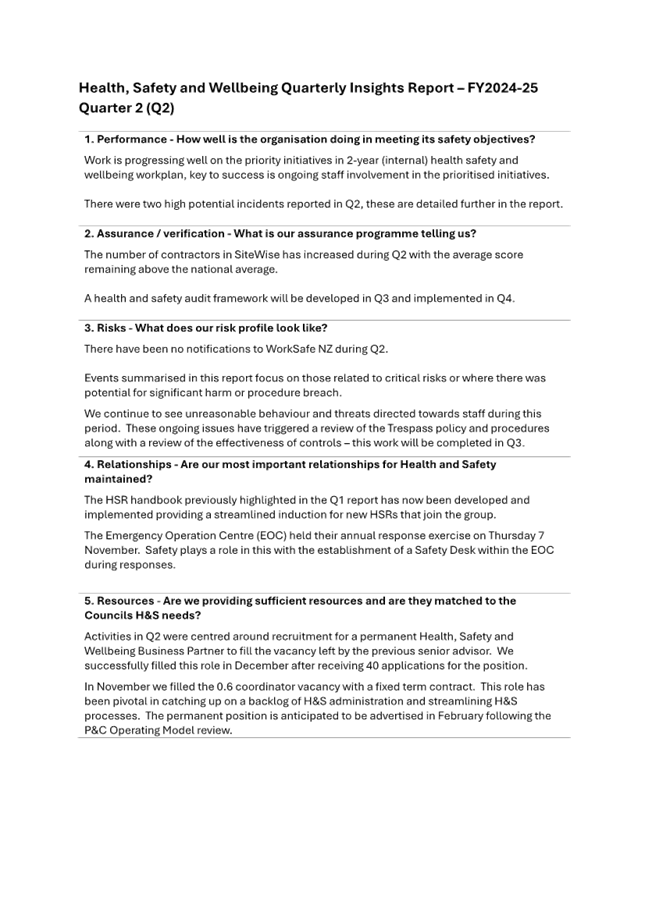
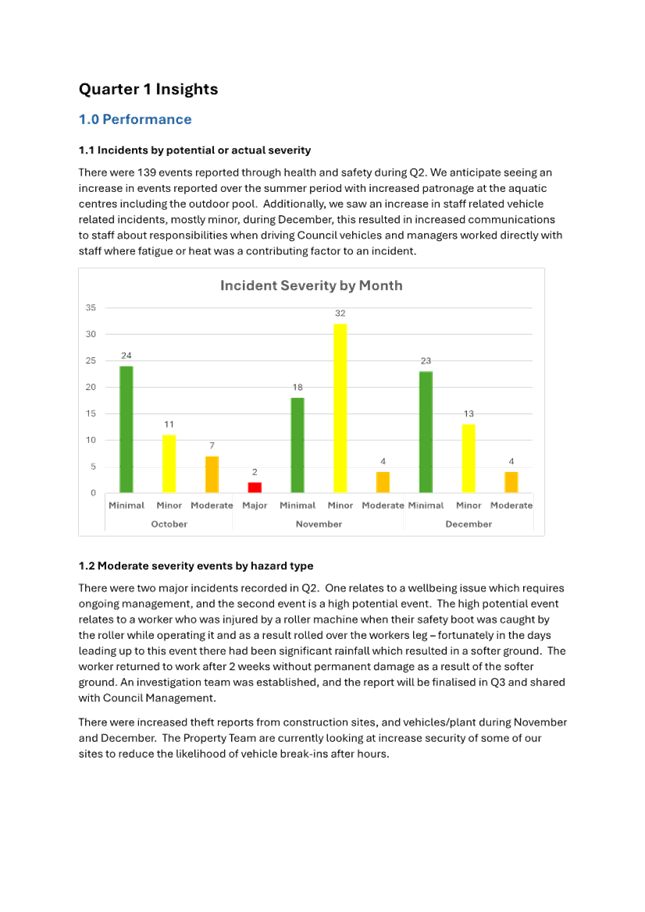





|
Risk and Assurance Committee Meeting Agenda
|
11 March 2025
|
9.4 Top 10 Organisational
Risk Report
Kaituhi |
Author: Nienke
Itjeshorst, Lead Risk and Assurance Advisor
Kaiwhakamana
| Authoriser: Mark de Haast, Group Manager Corporate Services
Te pūtake |
Purpose
1 This
report provides an update on the Top 10 Organisational Risks currently facing
the organisation.
He
whakarāpopoto | Executive summary
2 Not
required.
Te tuku haepapa
| Delegation
3 The
Risk and Assurance Committee has delegated
authority to consider this matter in line with section C.3 of the Governance
Structure and Delegations for the 2022-2025 triennium which state the committee
has delegation to:
· Ensure
that Council has in place a current and comprehensive risk management framework
and making recommendations to the Council on risk mitigation.
Taunakitanga | RECOMMENDATIONS
A. That the Risk and
Assurance Committee receives and notes this report, including Appendix 1 to
this report.
Tūāpapa | Background
4 The
Top 10 Organisational Risks are aimed at setting a clear direction for staff as
to what the Senior Leadership Team (SLT) have identified as the highest areas
of potential risk for the organisation to being able to successfully achieve
its objectives.
5 “Risk”
for the management of the council organisation is defined as:
a. the
impact of uncertain events that can happen in the future on the planned
objectives that SLT wants the organisation to deliver and/or achieve (short,
medium and long term), and
b. includes
strategic, reputational, regulatory, legal, security, change and operational
risks.
6 The
current Top 10 Organisational Risks are managed in a risk register in our
Enterprise Risk Management software: Camms Risk. It is important to note that
these risk listings are:
a. not
ranked in order of severity,
b. capped
at 10, to provide a clear focus for SLT and this Committee, and
c. not
‘set in stone,” an emerging organisational risk can be brought
forward to replace an existing risk when required and/or relevant.
7 Engagement
on the organisational risk profile is through on-going conversations with SLT
and activity managers about these risks, the controls to prevent or mitigate
these risks and status of risk treatments that are underway to implement the
controls to achieve the target risk level. These conversations ensure each risk
is regularly reviewed providing assurance that the treatments are being
conducted to further mitigate the risk.
8 The
next table identifies the current Top 10 Organisational Risks.
|
Risk No.
|
Risk Title
|
|
ORG 1
|
Loss of life, serious injury or illness due to
insufficient Health, Safety and Wellbeing management.
|
|
ORG 2
|
Failure to adequately maintain social licence.
|
|
ORG 3
|
Failure to give effect to Te Tiriti o Waitangi
|
|
ORG 4
|
Inadequate mitigation and adaptation responses to known
and future climate change challenges.
|
|
ORG 5
|
Failure to achieve legislative obligations.
|
|
ORG 6
|
Inadequate management of the impacts of central government
reform/change.
|
|
ORG 7
|
Inadequate safeguards against digital technology risks.
|
|
ORG 8
|
Failure to prudently manage Council’s financial
stability including fraudulent activity.
|
|
ORG 9
|
Failure to maintain business continuity for essential
services and inadequate planning and preparedness for emergencies.
|
|
ORG 10
|
Inability to attract and retain sufficient capacity to
deliver Council’s objectives.
|
9 A
list of AS/NZ/ISO 3100:2018 Standard: Risk Management – Guidelines
definitions is included in the Heatmap Report on the last page.
He
kōrerorero | Discussion
10 This report
provides an update of the current Top 10 Organisational Risks. The associated
Risk Heatmap Report (attached as Appendix 1 to this report), and details
how the organisation is treating and mitigating these risks, with progress
updates against each of the individual risk treatments.
11 All
updates/changes to the Risk Heatmap Report have been highlighted in blue font.
He
take | Issues
12 There
are no additional issues arising from this report.
Ngā
kōwhiringa | Options
13 There
are no options to be raised in this report.
Mana whenua
14 There
are no mana whenua considerations in addition to those included in Appendix 1
to this report.
Panonitanga Āhuarangi me te Taiao | Climate change
and Environment
15 There
are no climate change considerations in addition to those included in Appendix
1 to this report.
Ahumoni me ngā rawa | Financial
and resourcing
16 There
are no financial and resourcing considerations in addition to those included in
Appendix 1 to this report.
17 Tūraru ā-Ture me te Whakahaere
| Legal and Organisational Risk
There are no further legal and
risk considerations arising directly from this report.
Ngā pānga ki ngā kaupapa here | Policy impact
18 There
are no further policy considerations arising from this report.
Te whakawhiti
kōrero me te tūhono | Communications & engagement
Te mahere tūhono | Engagement
planning
19 This
matter has a low level of significance under the Council’s Significance
and Engagement Policy and no engagement is triggered.
Whakatairanga |
Publicity
20 This
report and appendices will be publicly available through the agenda for the
Risk and Assurance Committee meeting.
Ngā āpitihanga | Attachments
1. Top
10 Organisational Risks Heatmap Report 11 March 2025 ⇩ 
|
Risk and Assurance Committee Meeting Agenda
|
11 March 2025
|



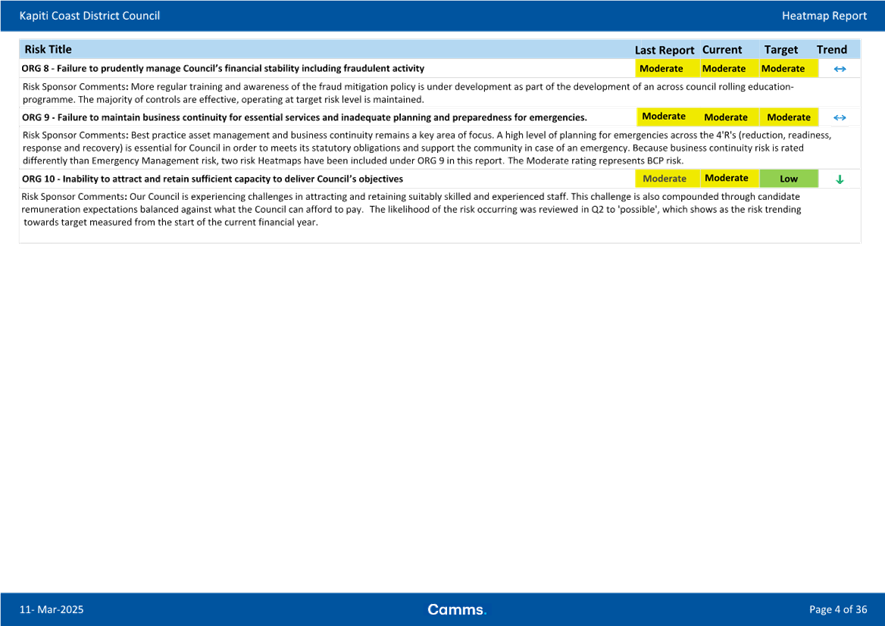
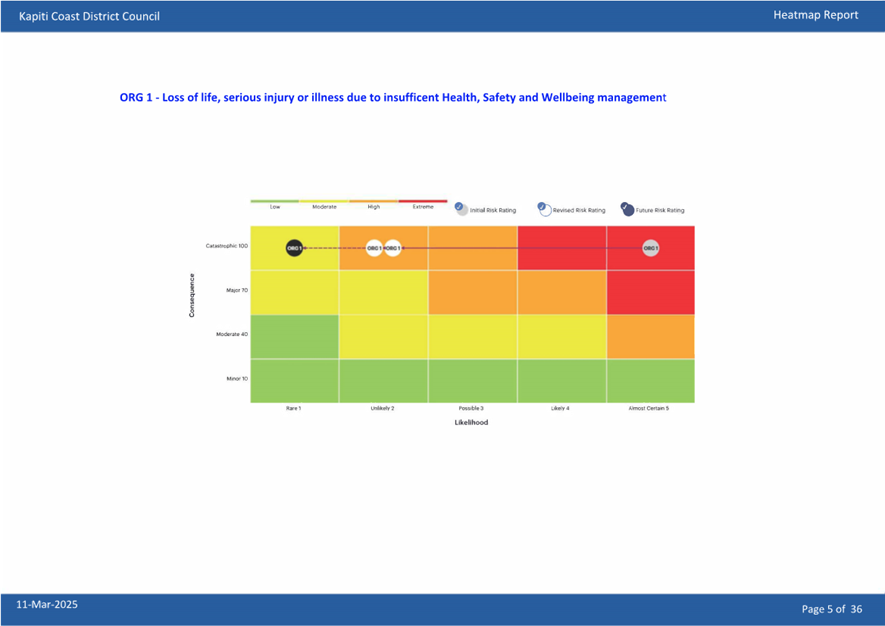
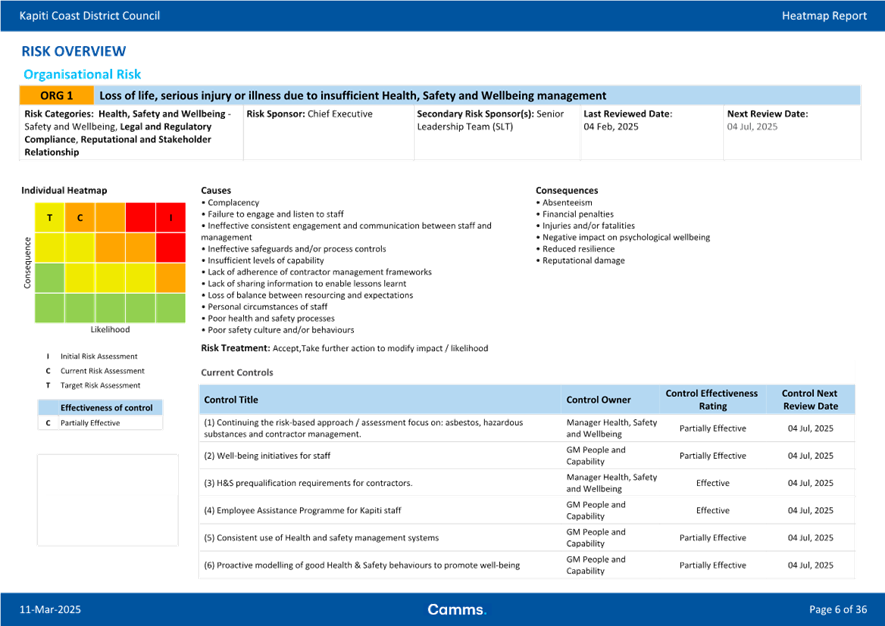
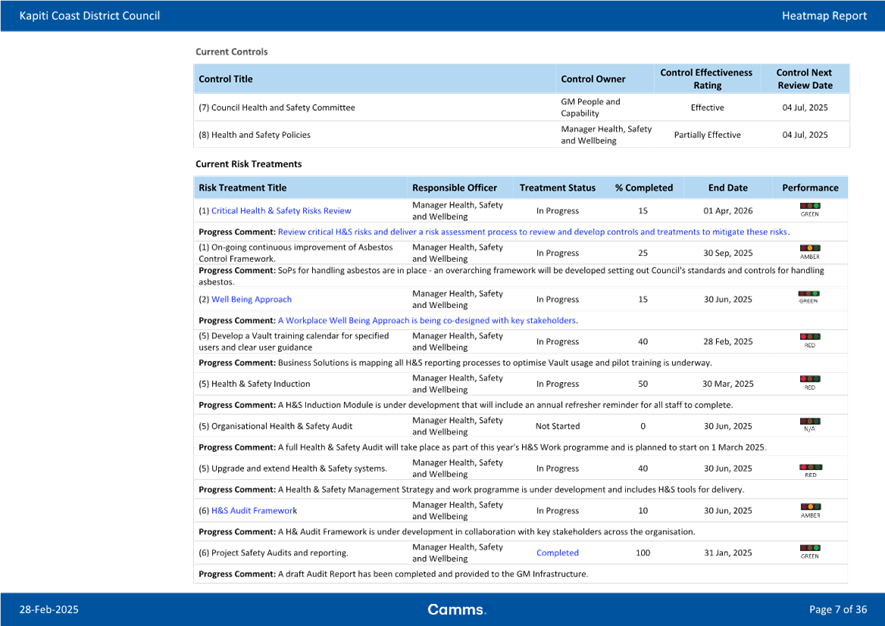
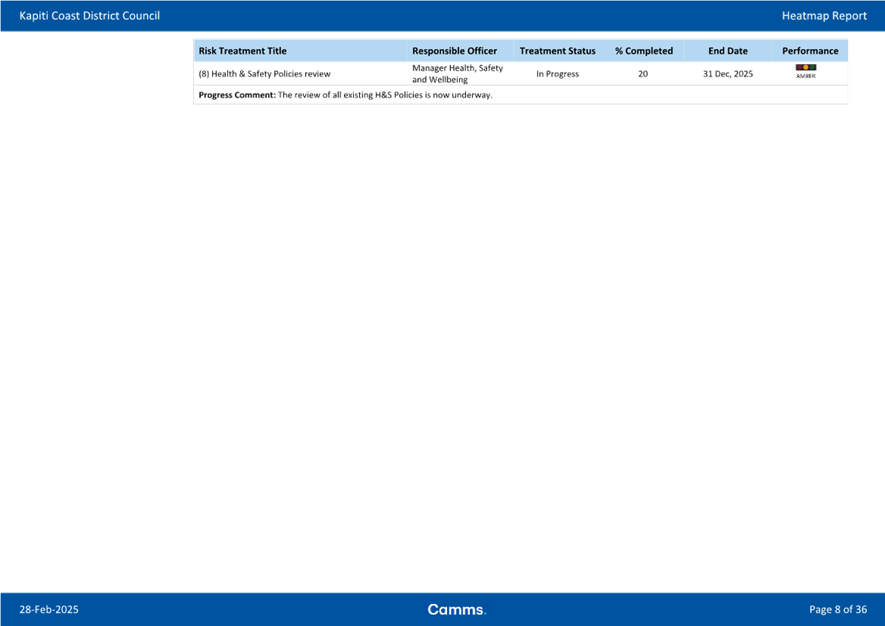
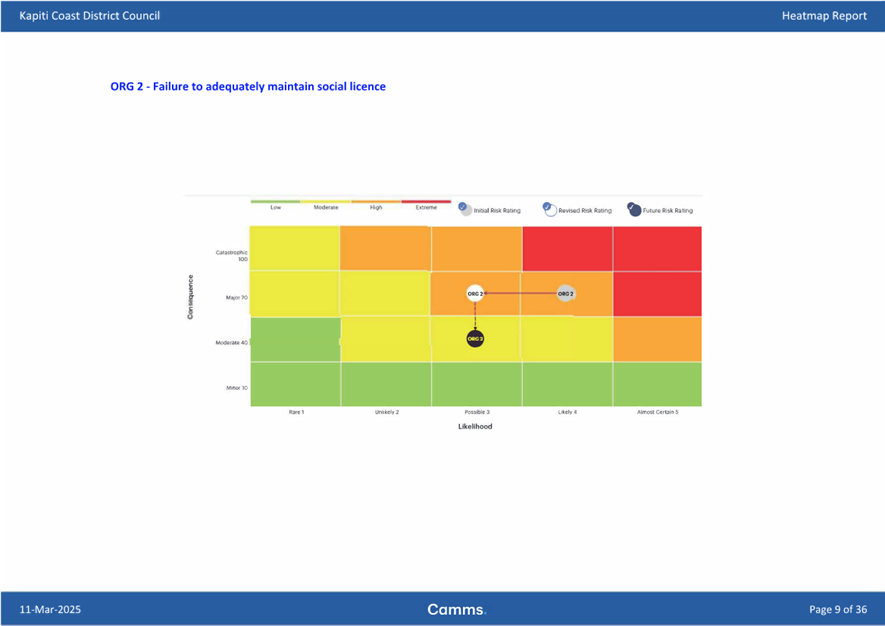
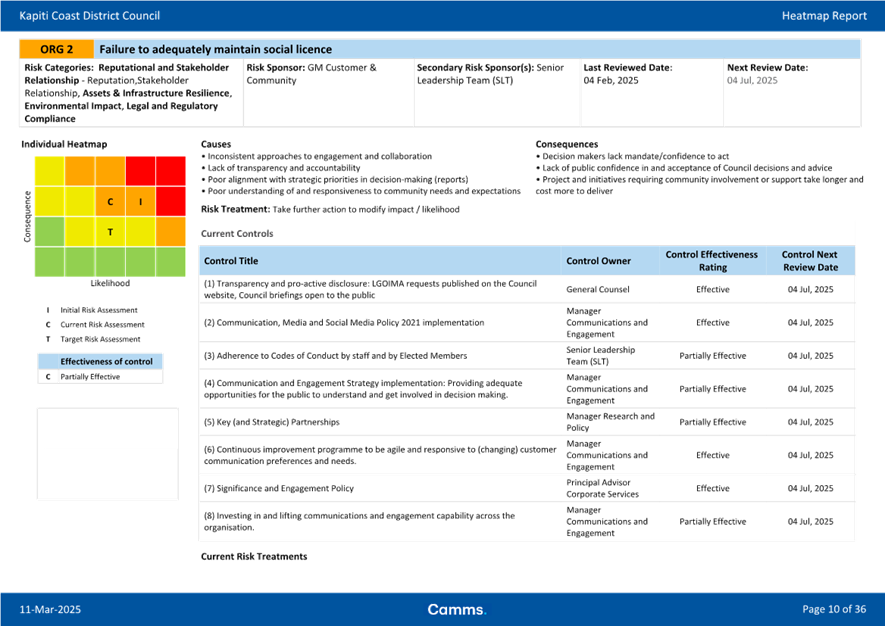
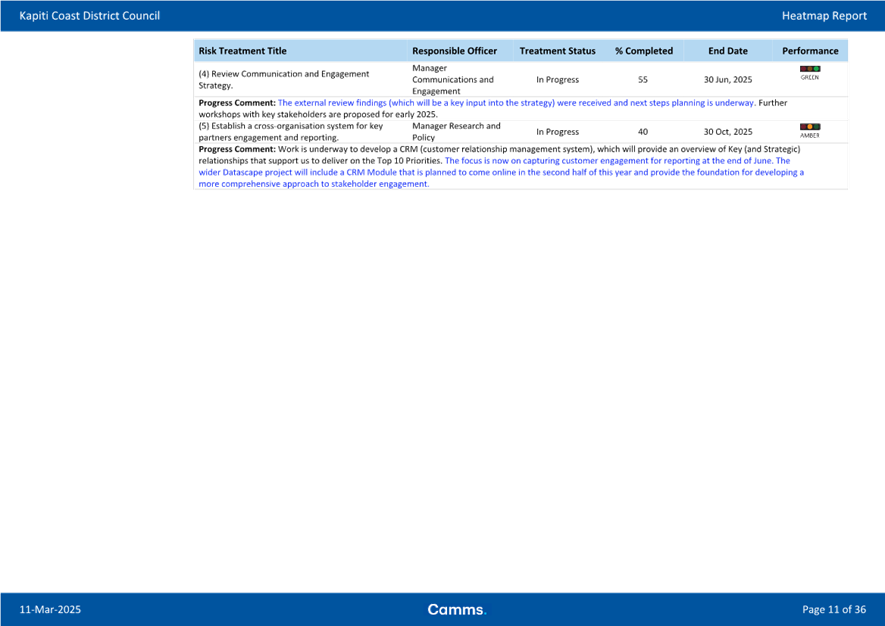
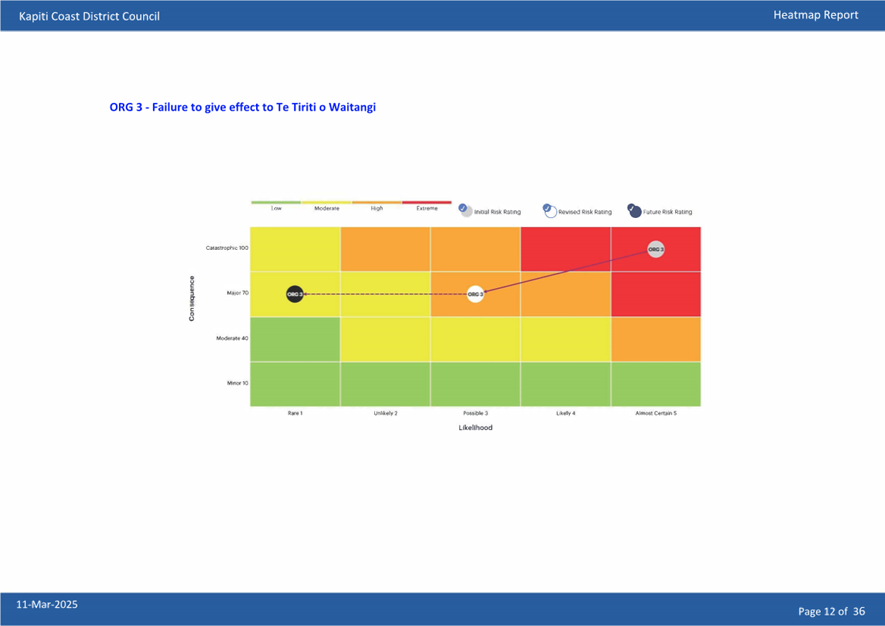
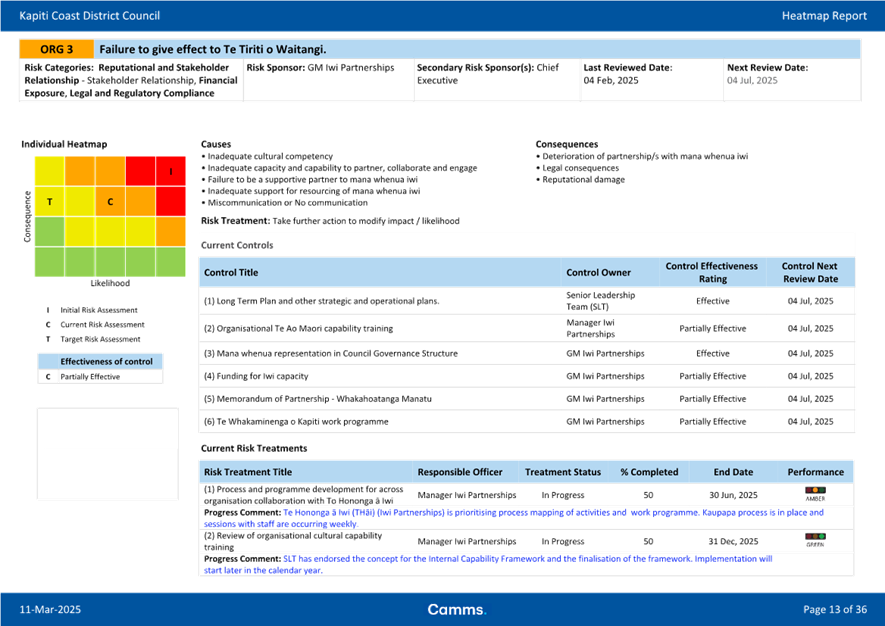


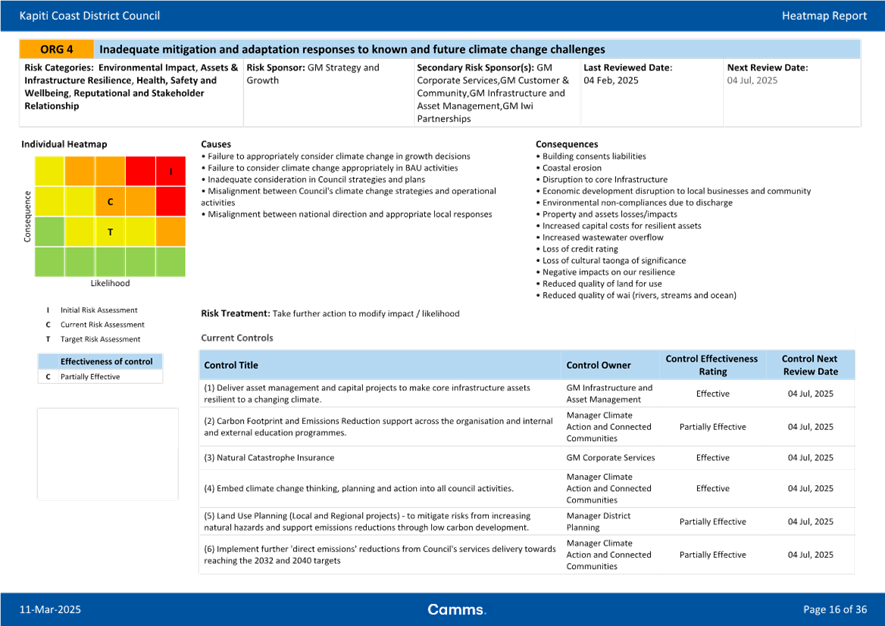
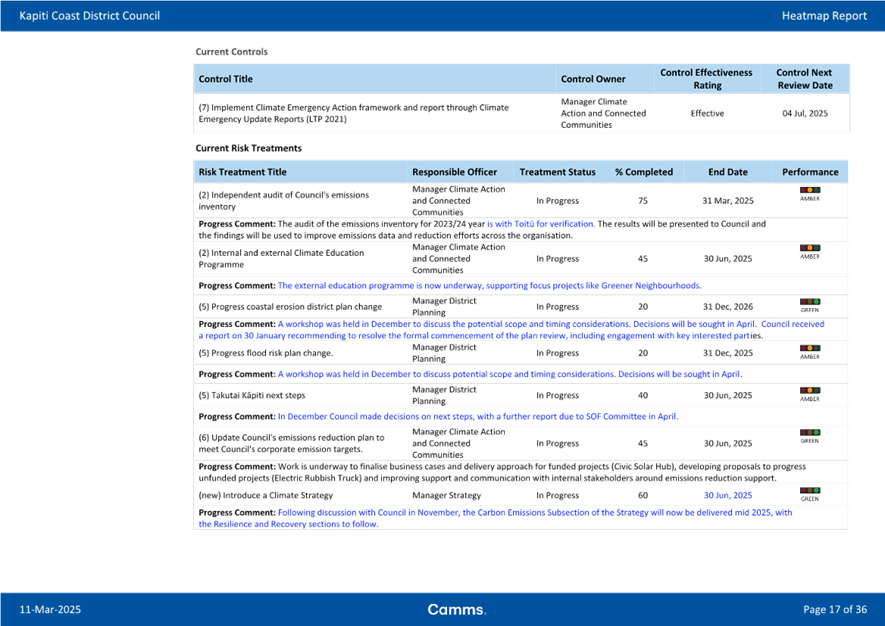
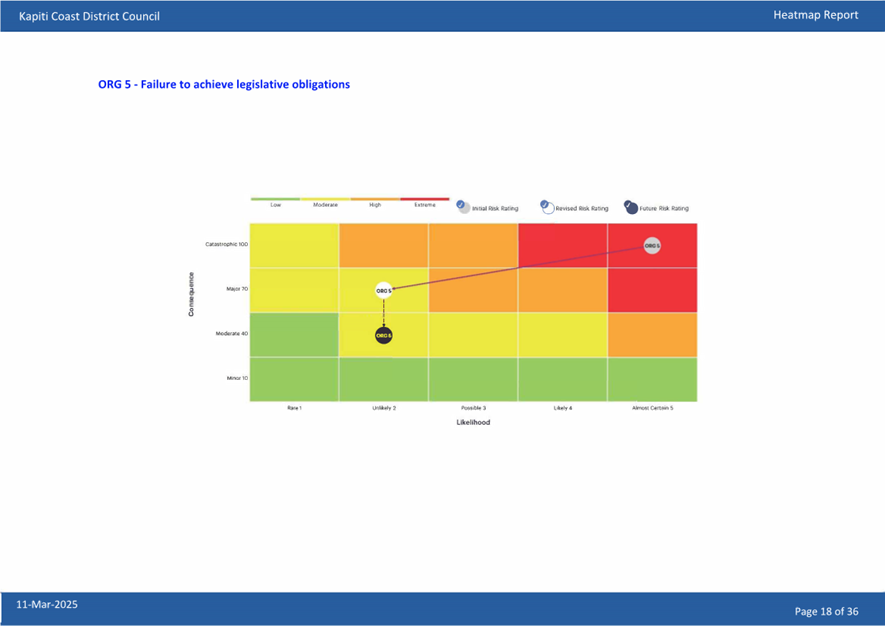
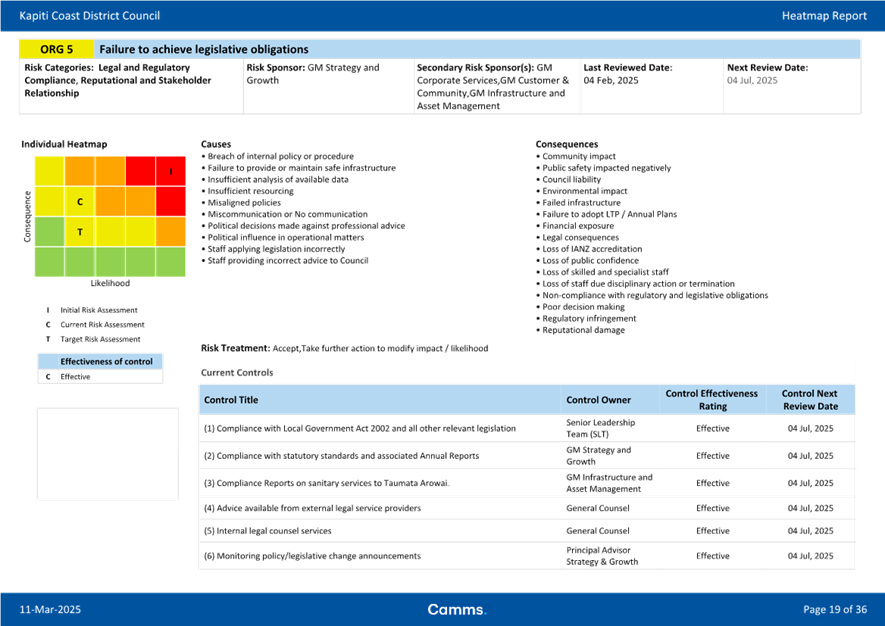
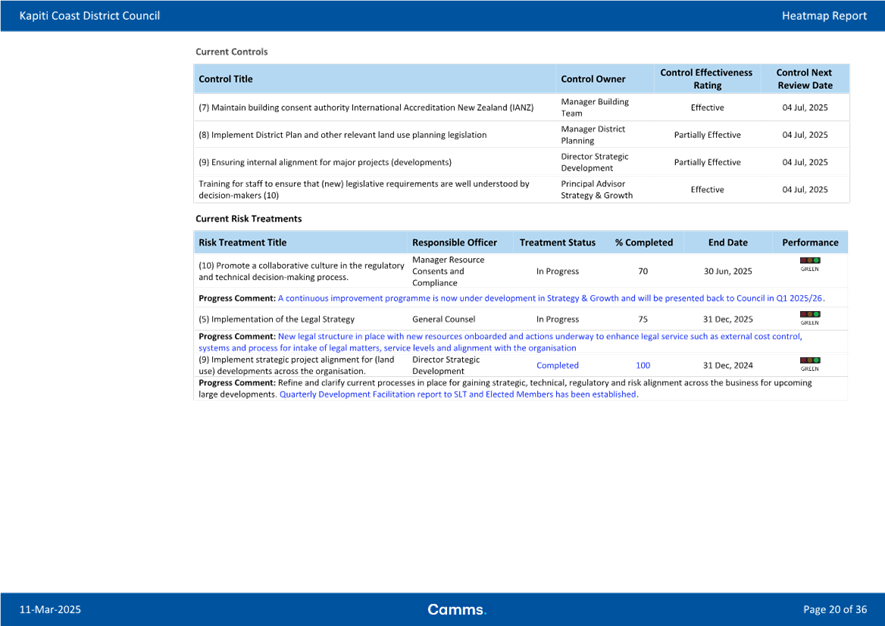
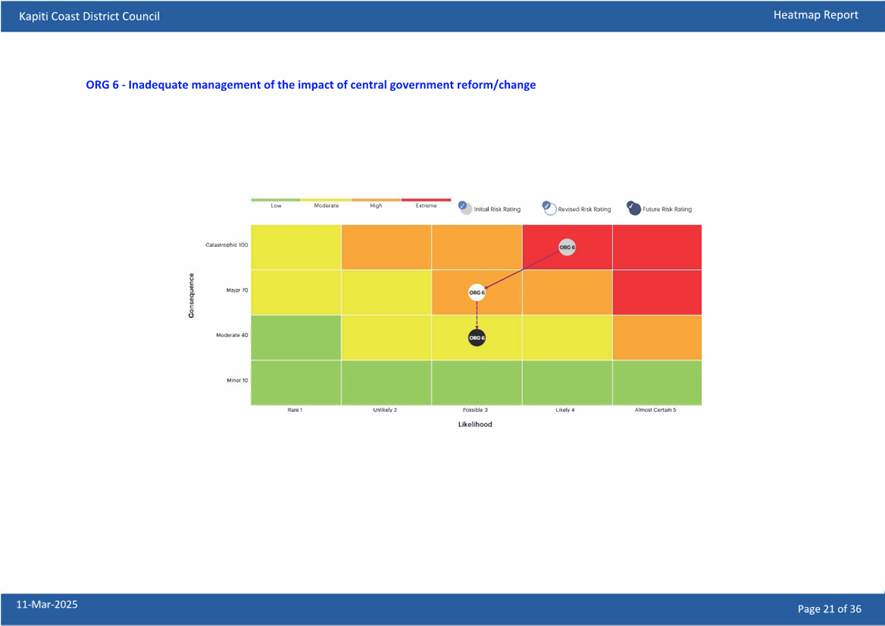
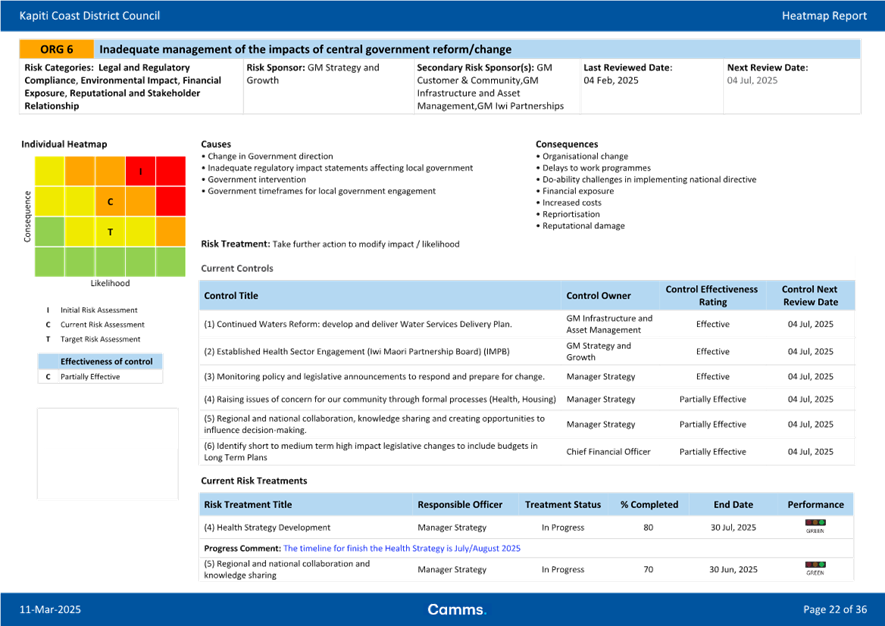
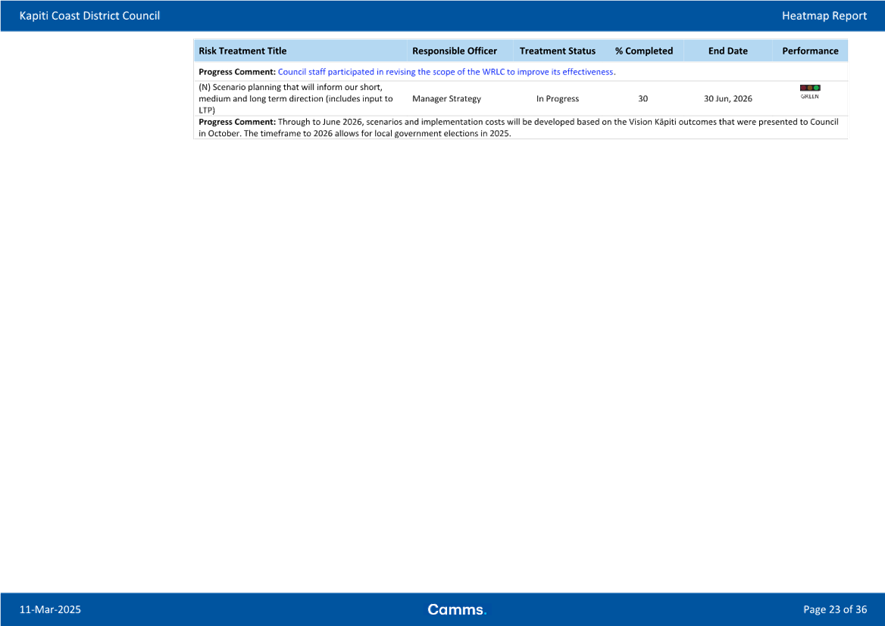
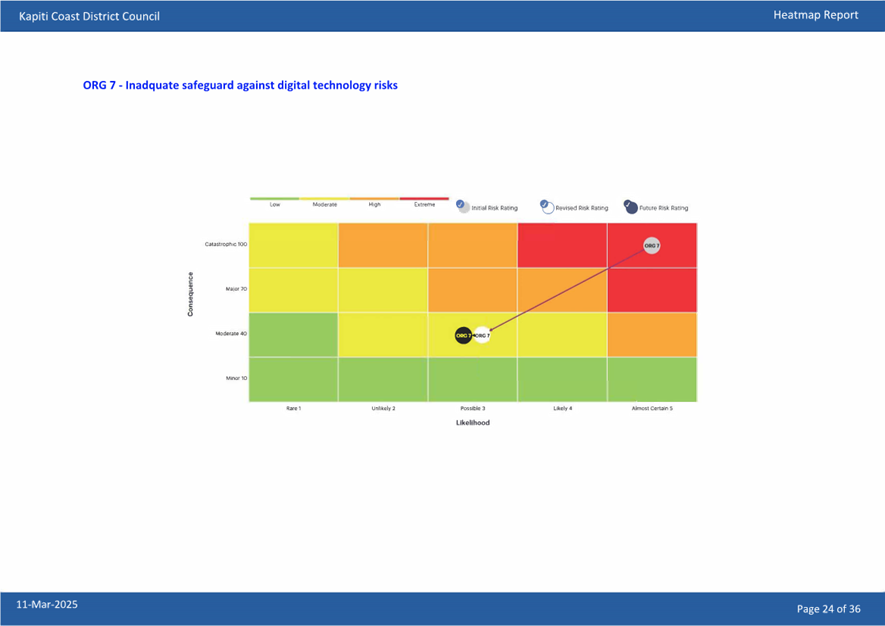
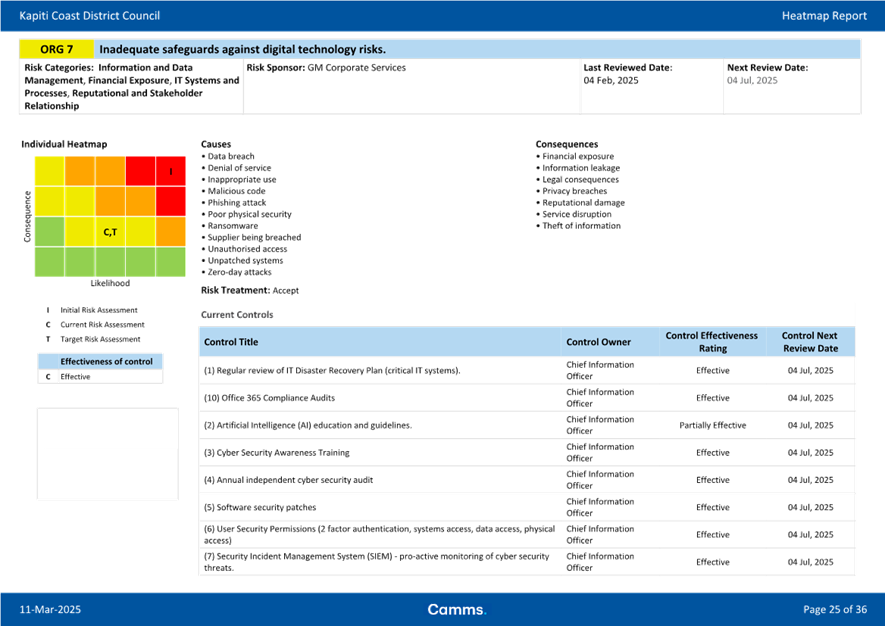
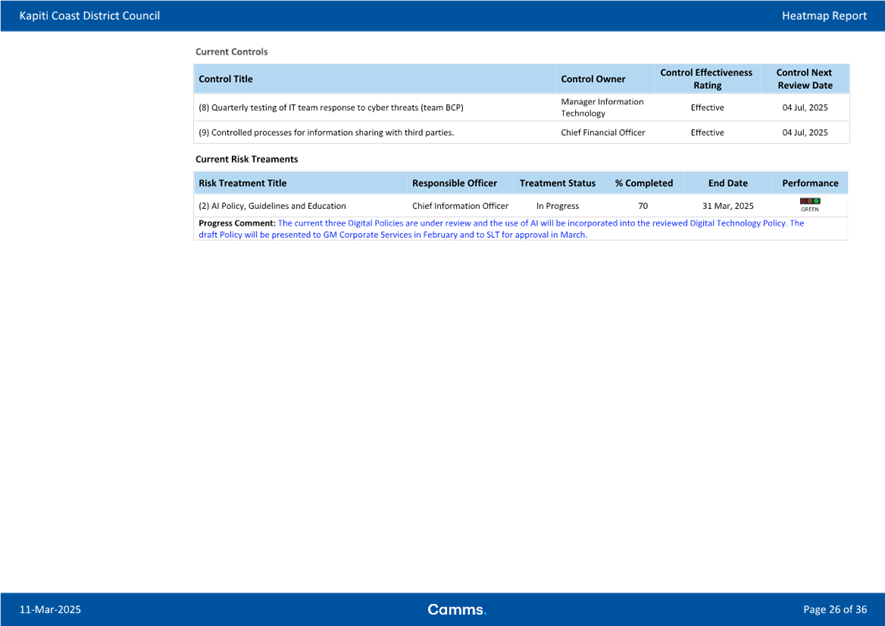
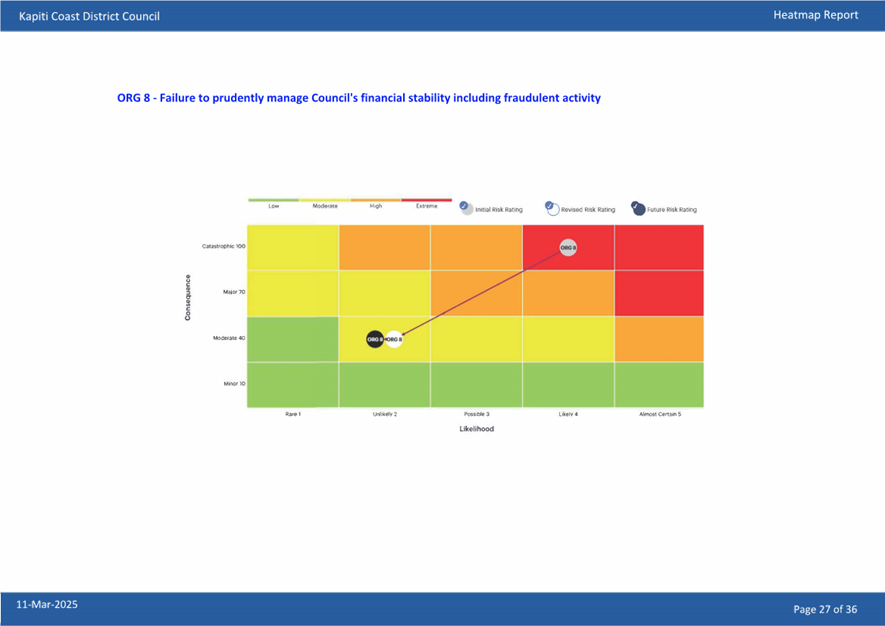
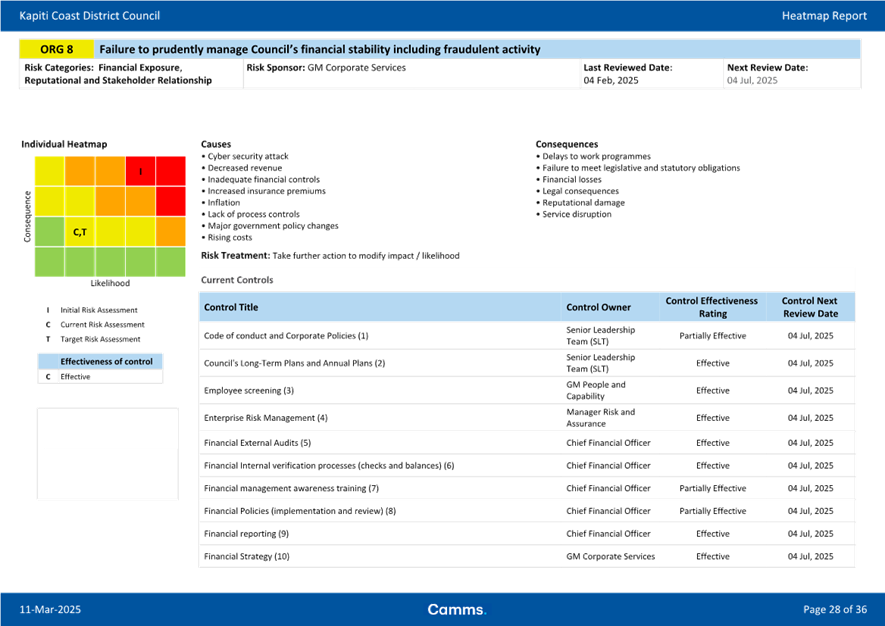
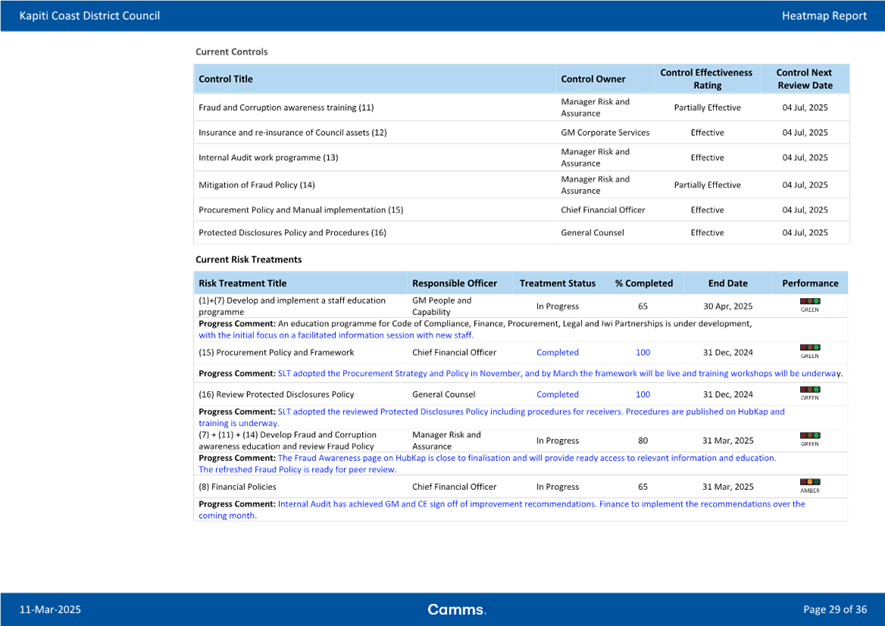
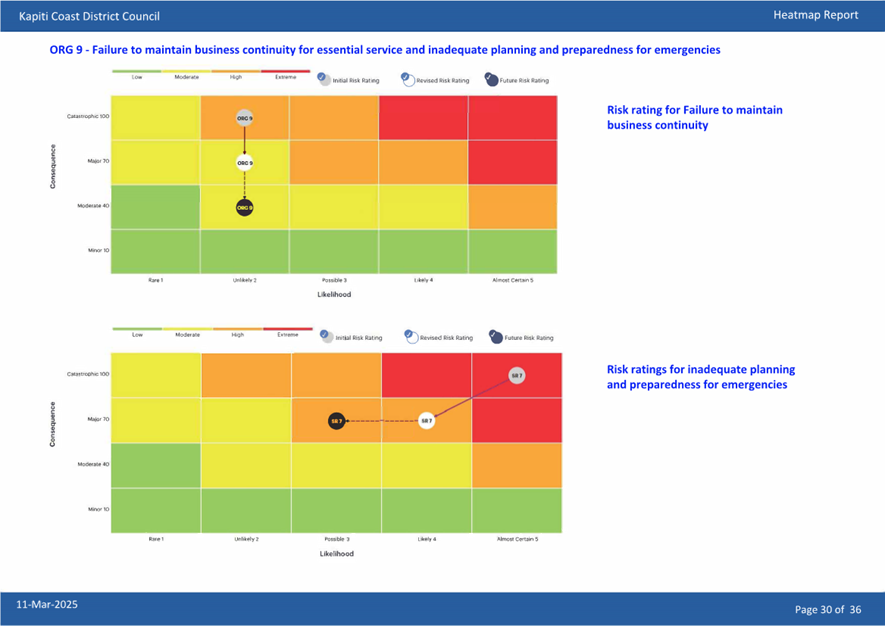
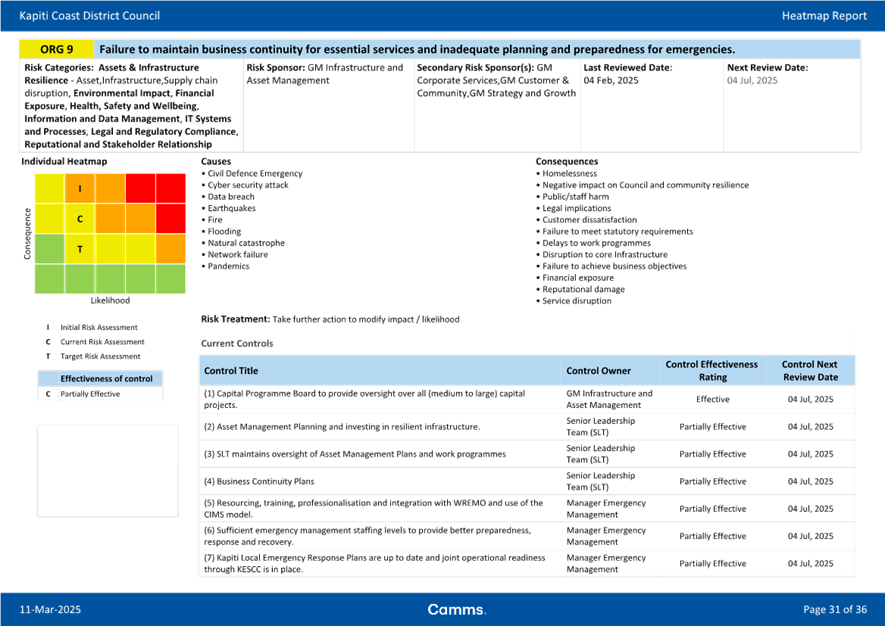
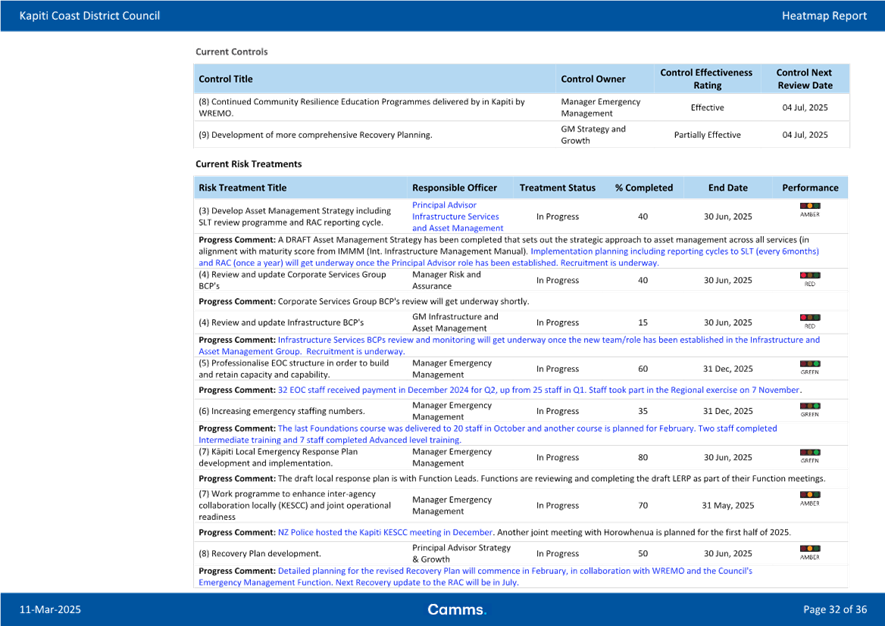
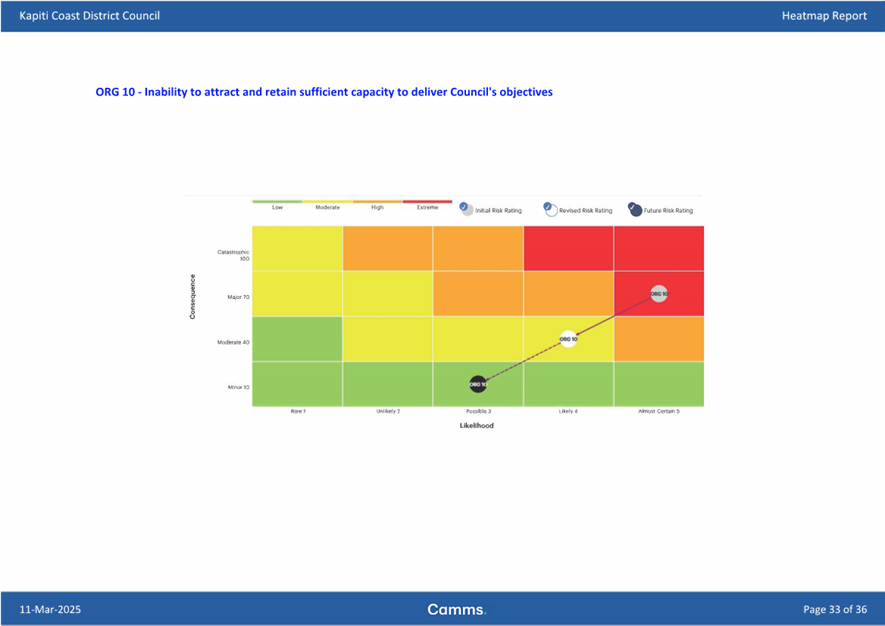
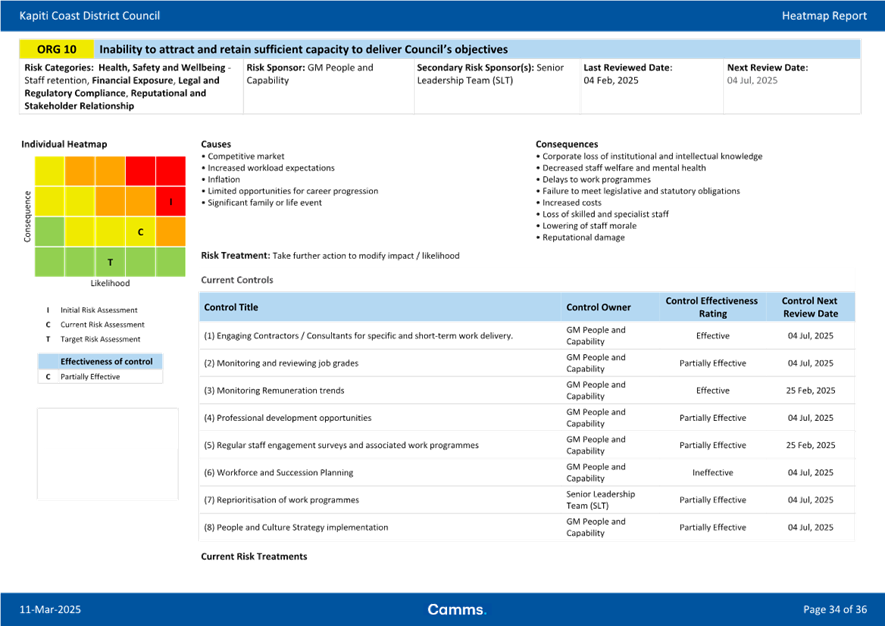
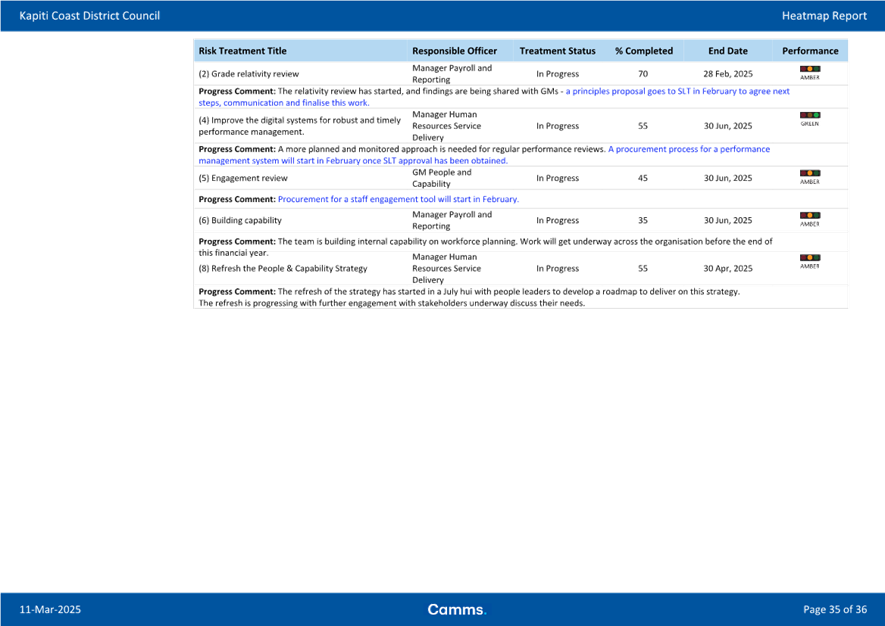
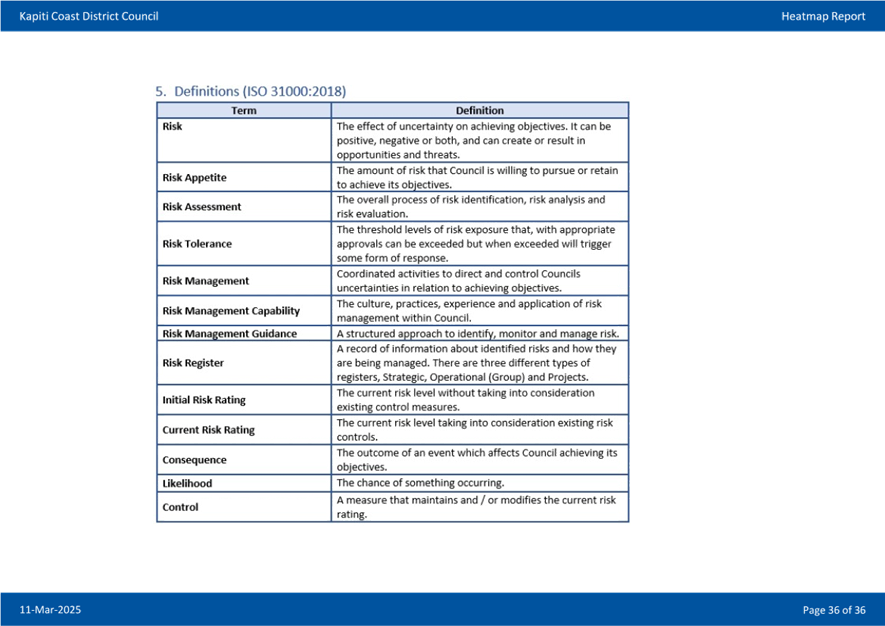
|
Risk and Assurance Committee Meeting Agenda
|
11 March 2025
|
9.5 Internal
Audit Work Programme Update
Kaituhi | Author: Sharon
Foss, Manager Risk and Assurance
Kaiwhakamana | Authoriser: Mark de Haast, Group Manager Corporate Services
Te
pūtake | Purpose
1 This report gives the Risk and Assurance Committee a progress update
on the 2024 Internal Audit work programme together with a summary of the
findings for each audit and seeks approval of the internal audit focus through
to the close of the triennium.
He
whakarāpopoto | Executive
summary
2 This report does not require an Executive Summary.
Te
tuku haepapa | Delegation
3 The Committee has delegated authority to
consider this matter in line with section C.3 of the Governance Structure and
Delegations for the 2022 – 2025 triennium which state that the committee
has the delegation to:
· Ensure that the Council has in place a current and comprehensive
risk management framework and making recommendations to the Council on risk
mitigation.
Taunakitanga | RECOMMENDATIONS
A. That the
Risk and Assurance Committee receives and notes the progress update on the 2024
Internal Audit work programme.
B. That
the Risk and Assurance Committee receives and approves the 2025 internal audit work programme until the end of the
triennium.
Tūāpapa | Background
4 Internal audit is line three of the ‘Four Lines of
Defence’ model used in the Risk and Assurance workstream.

\
5 Each
of the following four sources of assurance contributes to the overall assurance
level and shows their integration into Council business.
First line: Day-to-day risk management and control by those responsible for
specific objectives or processes.
Second line: Council
oversight to ensure the control framework operates effectively.
Third line: Internal
audit providing reasonable assurance of governance, risk management, and
controls.
Fourth line: Assurance
from external independent bodies like external auditors.
6 The Internal audits are ranked in accordance with NZ Auditing
Standards and Council’s external auditors (EY).
|
High Risk
|
Matters and/or issues considered to
be fundamental to the mitigation of material risk, maintenance of
internal control or good corporate governance.
|
|
Moderate Risk
|
Matters and/or issues considered to
be of major importance to maintenance of internal control, good
corporate governance, or best practice for processes.
|
|
Low Risk
|
A weakness
which does not seriously detract from the internal control framework.
|
7 This Committee has approved the internal audit work
programme and received regular updates. Presentation of this update concludes
the 2024 internal audit work programme.
8 The internal audit process collects evidence on business
effectiveness, with managers and Group Managers (GMs) verifying the findings. The
Chief Executive approves the final reports and relevant GM’s then
commence work on the audit recommendations. Updates are shared with Ernst &
Young as a contribution to their external audits.
He
kōrerorero | Discussion
9 Completion of the blue audit entries below concludes the 2024 internal audit
work programme.
10 The green
audit entries are the 2025 internal audit work programme until the end of this
triennium. This focus addresses a problem identified by the Chief Executive:
not enough resources to complete audit recommendations. This decision helps
reduce the risk of not improving policy and procedure effectiveness, which
could affect the organisation both internally and externally.
|
Risk
|
#
|
Assurance Activity (third line of Defence)
|
Status: Feb 2025
|
|
Audit
|
|
High
|
1
|
Audit Mitigation of Fraud Policy
|

|
Completed 2023-24
|
|
High
|
2
|
Audit Procurement Policy Framework
|

|
|
High
|
3
|
Audit Employee
Code of Conduct document
|

|
Completed February 2025
|
|
High
|
4
|
Audit Employee
Conflict of Interest Declarations
|

|
|
High
|
5
|
Audit General Expenses Policy
|

|
|
Moderate
|
6
|
Audit Protected Disclosures
(Protection of Whistleblowers) Policy
|

|
|
Moderate
|
7
|
Audit Receipt
of Gifts & Hospitality Policy
|

|
|
Monitor
|
|
Moderate
|
8
|
Monitor
resolution of EY Control Findings
|

|
In progress
|
|
Assurance Support
|
|
Moderate
|
9
|
Provide assurance support to Datascape project as
requested by GM, Corporate Services (CS).
|

|
n/a to date
|
|
Moderate
|
10
|
Provide assurance support to managers with completion
of their audit recommendations as requested by GM, CS
|

|
In progress
|
He
take | Issues
Internal Audit Findings
11 Common
problems identified in the audits include low awareness of policy requirements,
lack of regular communication and training to boost awareness, compliance, and
accountability. The audits highlight the need for better training and
obligation reminders for employees.
12 Internal
audits form part of enterprise risk management and are a continuous improvement
tool. Findings from internal audits reflect exact quantification of controls
(i.e. pass or fail) and this approach helps continuously improve the
Council’s first and second lines of defence.
13 The following table
summarises the internal audit findings by way of key themes. These finding
and/or themes are considered to be low risk as they do not reflect serious
weaknesses in the Council’s overall control framework. Moreso, these
findings/and or themes better reflect opportunities to further strengthen and
improve the Council’s overall control framework.
|
Summary
of
High Level Themes
|
Code of Conduct
|
Conflict of Interest
|
General Expenses
|
Gifts and Hospitality
|
Protected Disclosures
|
|
Low profile. Not enough
compliance reminders
|
X
|
X
|
|
X
|
X
|
|
Hard to follow
|
X
|
X
|
X
|
|
X
|
|
Incomplete or
inconsistent requirements
|
X
|
X
|
X
|
|
|
|
No training or Induction
|
|
X
|
|
X
|
X
|
|
Processes don’t
always align with policy requirements
|
X
|
X
|
X
|
X
|
|
|
Little or no compliance
monitoring
|
|
X
|
X
|
X
|
|
Summary of Internal Audit
Findings
Code of
Conduct Audit
14 The audit
identified 20 findings and made 28 recommendations.
15 The Code of Conduct includes all content
recommended by the Office of the Auditor General and outlines expected
behaviours for employees. However, it has a low profile on HubKap and is not
often referenced in messaging to employees.
16 The
audit findings are:
16.1 The Code
of Conduct is an important guiding document for the Council but it has a low
profile within the organisation.
16.2 Requirements
of the Code do not always appear easy for employees to identify & follow.
16.3 There
are areas of the Code that are out of alignment with current practice or do not
show linkages to other parts of the document or other policies.
Conflict of
Interest Audit
17 The audit
identified 15 findings and made 18 recommendations.
18 Requirements for conflicts of interest not related to
procurement are documented in the Code of Conduct. The separation of the
procurement from the general conflict of interest declaration form towards the
end of 2023 resulted in
Council being without a standard conflict declaration form for some time. An
old version of the form has now been added back onto HubKap as an interim
measure while changes are considered.
19 Increasing the understanding and profile surrounding
conflicts of interest would be beneficial for the organisation.
20 The
audit findings are:
20.1 The Conflict
of Interest guidance on the current process is incomplete.
20.2 Employees are not provided with education or reminders
about non-procurement related conflicts.
20.3 Information about non-procurement related conflicts has gaps, can be
confusing and is inconsistent in some places.
General
Expenses Audit
21 The
audit identified 15 findings and made 42 recommendations.
22 The
General Expenses Policy is not being followed consistently by employees.
Reasons for non-compliance was often due to employees not understanding the
requirements or because current processes do not ensure that all Policy
requirements are met. Some of these issues may be resolved with the Datascape
project. There is an opportunity to carry out additional monitoring to ensure
that spending meets Policy requirements.
23 The
audit findings are:
23.1 Policy requirements
are not followed consistently.
23.2 There
are requirements set out in the Policy and related guidance that are not being
adhered to due to gaps in the processes currently in place.
23.3 It
is not always possible to tell what has been purchased, or why, from the
information in MagiQ.
23.4 Monitoring
of Policy requirements is limited.
Gifts
and Hospitality Audit
24 The audit identified
16 findings and made 22 recommendations.
25 The
Receipt of Gifts and Hospitality Policy contains the required rules for the
acceptance of gifts in the workplace. However, without regular communication to
employees about the Policy’s requirements, it is being overlooked and the
rules are not being followed.
26 The
audit findings are:
26.1 Policy requirements are not being followed.
26.2 The
Policy does not provide an overview of the process to follow to notify and gain
permission to accept gifts.
26.3 There is
no strong messaging to employees about the need for Policy compliance in order
to guard against reputational damage and the perception of impropriety.
26.4 Policy
compliance is not being monitored or reported.
Protected
Disclosures (Protection of Whistleblowers) Policy Audit
27 The
audit identified 7 findings and made 7 recommendations. Note
since the internal audit was carried out many of these findings have now been
addressed and work already completed by the Legal Team following SLT direction
to amend the Corporate Policy to a procedure.
28 The
Protected Disclosures (Protection of Whistleblowers) Policy has been replaced
by a new procedures document and the formal legal terminology on HubKap has
been replaced by plain language which is easier to understand. Further work to
increase staff awareness is recommended.
29 The
audit findings are:
29.1 No
training or education modules are available and staff are not reminded about
protected disclosures.
Ngā
kōwhiringa | Options
30 There are no options to be raised in this report.
Mana whenua
31 There are no mana whenua considerations arising from this report.
Panonitanga
Āhuarangi me te Taiao | Climate
change and Environment
32 There are no climate change
issues arising from this report.
Ahumoni
me ngā rawa |
Financial and resourcing
33 There are no further financial
and resourcing considerations arising from this report.
Tūraru
ā-Ture me te Whakahaere |
Legal and Organisational Risk
34 There are no legal or further risk considerations arising from this
report. EY as our external audit partner have received copies of the
full audit reports.
Ngā pānga
ki ngā kaupapa here | Policy impact
35 There are no policy implications arising from this report.
Te whakawhiti kōrero me te tūhono
| Communications
& engagement
Te mahere
tūhono | Engagement planning
36 This matter has a low level of significance under Council’s
Significance and Engagement Policy and no engagement is triggered.
Whakatairanga | Publicity
37 This
report and appendices will be publicly available through the agenda for the
Risk and Assurance Committee meeting.
Ngā āpitihanga | Attachments
Nil
|
Risk and Assurance Committee Meeting Agenda
|
11 March 2025
|
9.6 Legislative
Compliance 1 October to 31 December 2024
Kaituhi |
Author: Sarah
Wattie, General Counsel
Kaiwhakamana
| Authoriser: Mark de Haast, Group Manager Corporate Services
Te pūtake | Purpose
1 The purpose of this report
is to notify the committee of legislative non-compliance in the second quarter
of the financial year, 1 October 2024 to 31 December 2024.
He
whakarāpopoto | EXecutive summary
2 An
executive summary is not required.
Te tuku
haepapa | Delegation
3 The
Risk and Assurance Committee has delegated authority to consider this report
under section C3 of the Governance Structure and Delegations document for the
2022-2025 triennium. These delegations include:
· ensuring
that the Council has in place a current and comprehensive risk management
framework and making recommendations to the Council on risk mitigation.
assisting elected members in the discharge of their
responsibilities by ensuring compliance procedures are in place for all
statutory requirements relating to their role.
Taunakitanga | RECOMMENDATIONS
A. That the Risk and Assurance Committee notes legislative
non-compliance for the second quarter of the financial year from 1 October 2024
to 31 December 2024 as outlined in Attachment 1 to this report.
Tūāpapa |
Background
4 Local government is
governed by a complex statutory framework with the Council responsible for a
range of legislative requirements. Legislative compliance is important to the
Council carrying out its functions under the Local Government Act 2002 in a fair
and effective manner that is accountable to the local community. Failure to
achieve Council’s legislative obligations has also been identified as one
of the Council’s top 10 risks.
5 Each quarter key Council
staff responsible for the Council’s compliance with legal obligations
under different Acts are asked to complete a quarterly declaration of known
non-compliance with legislative requirements and key assurance areas being privacy,
procurement, authorised expenditure, cyber security and Local Government
Official Information and Meetings Act 1987 (LGOIMA) requirements.
6 Council staff are asked to
report against all applicable legislation. A legislative compliance schedule
exists to assist staff in completing this declaration, set out in Attachment 2
to this report. The Council’s external auditors have identified the
following legislation and regulations where non-compliance could have a
fundamental effect on operations:
· Local Government
Act 2002
· Local Authorities
(Members’ Interests) Act 1968
· Local Government
(Rating) Act 2002
· Local Government
(Financial Reporting and Prudence) Regulations 2014
· Building Act 2004
· Resource
Management Act 1991.
He
kōrerorero | Discussion
7 This section sets out legislative
compliance breaches for the second quarter of the financial year, 1 October
2024 to 31 December 2024, against all applicable legislation with risk ratings,
corrective actions and status assigned for each breach. It also provides an
assurance against key assurance areas outlined above being privacy, procurement,
authorised expenditure, cyber security and LGOIMA.
Organisational Risk Levels
8 Organisational risks levels
have been assigned to legislative compliance breaches reported to this
Committee based on the Council’s organisational risk framework. The risk
levels are set out below, noting that the assigned Risk Levels in Attachment 1 account
for an assessment of the risk and corrective actions taken together:
|
Organisational Risk Levels
|
|
High
|
· Matters
and/or issues considered to be fundamental to the mitigation of material
risk, maintenance of internal control or good corporate governance.
|
|
Moderate
|
· Matters
and/or issues considered to be of major importance to maintenance of internal
control, good corporate governance, or best practice for processes.
|
|
Low
|
· A weakness which does not seriously detract from the internal
control framework.
|
Key Assurance
Areas
9 The Risk and Assurance
Committee has requested the following key assurance areas be reported on in
additional to legislative compliance:
· Privacy
breach: A privacy breach is not meeting the requirements of the Privacy Act
2020 which may include releasing personal information to someone not authorised
to receive it or using personal information in an unauthorised way.
· Procurement
breach: A procurement or probity breach is a failure to follow the
requirements of Council’s procurement policy, which sets out the
requirements for our staff to ensure they carry out procurement in a way that
is transparent, accountable, impartial and equitable.
· Unauthorised
expenditure: Unauthorised expenditure is expenditure that breaches
Council’s finance and purchasing policies, such as a staff member
spending money without the appropriate financial delegation.
· Cyber
security breach: A cyber security breach is a breach of Council’s
information security systems which may result in the disclosure of sensitive,
personal or commercial information to persons who are not authorised to receive
the information, including members of the public.
· Local
Government Official Information and Meetings Act 1987 (LGOIMA): A breach of
this act relates to failure to meet deadlines or requirements for official
information requests, land information memorandum (LIM) requests, and
transparency and notification requirements relating to Council, committee and
community board meetings.
10 Confidential investigations are not
included in this legislative compliance report and will be reported in public
excluded where required.
11 Table
1: Assurance against key risk areas
|
Risk area
|
Description
|
|
Privacy
|
There were two privacy breaches
reported in the period.
|
|
Procurement
|
There were no reported
procurement breaches in the period.
|
|
Unauthorised expenditure
|
There was no reported
unauthorised expenditure in the period.
|
|
Cyber security
|
There were no reported cyber
security breaches in the period.
|
|
LGOIMA
|
There was one reported LGOIMA breach in the period.
|
12 Legislative compliance breaches for
the second quarter of the financial year are set out in Attachment 1 to this
report. These include ongoing breaches previously
reported to this Committee, where staff are still working on mitigations.
He take | Issues
13 There
are no issues for this report.
Ngā
kōwhiringa | Options
14 There
are no options required for this report.
Mana whenua
15 The Council has a partnership with
local iwi and hapū on the Kāpiti Coast District represented by Te
Rūnanga O Toa Rangātira, Ngā Hapū o Ōtaki and Āti
Awa ki Whakarongotai Charitable Trust.
16 The Council’s accountability to
the community on legislative compliance extends to its partnership with iwi and
commitments made to reflect the obligations under Te Tiriti o Waitangi, as well
as other obligations to Māori, mana whenua and tangata whenua under the
Local Government Act 2002, Resource Management Act 1987 and other
legislation.
Panonitanga āhuarangi | Climate change
17 There
are no climate change implications arising directly from this report.
Ahumoni me
ngā rawa | Financial and resourcing
18 There
are no financial implications arising directly from this report.
Tūraru
ā-Ture me te Whakahaere |
Legal and Organisational Risk
19 Except
for the issues noted in this report, there are no other legal or risk
implications.
Ngā pānga ki ngā
kaupapa here | Policy impact
20 There
are no policy implications arising directly from this report.
TE whakawhiti kōrero me te tūhono | Communications & engagement
21 This report is for the purpose of
providing information only and does not trigger the Council’s
Significance and Engagement policy.
Te mahere tūhono | Engagement planning
22 There
is no requirement for engagement planning.
Whakatairanga | Publicity
23 There
are no additional publicity considerations arising directly from this
report.
Ngā
āpitihanga | Attachments
1. Legislative
Compliance Breaches and Updates 1 October 2024 to 31 December 2024 ⇩ 
2. Legislative
Compliance Schedule ⇩ 
|
Risk and Assurance Committee Meeting Agenda
|
11 March 2025
|
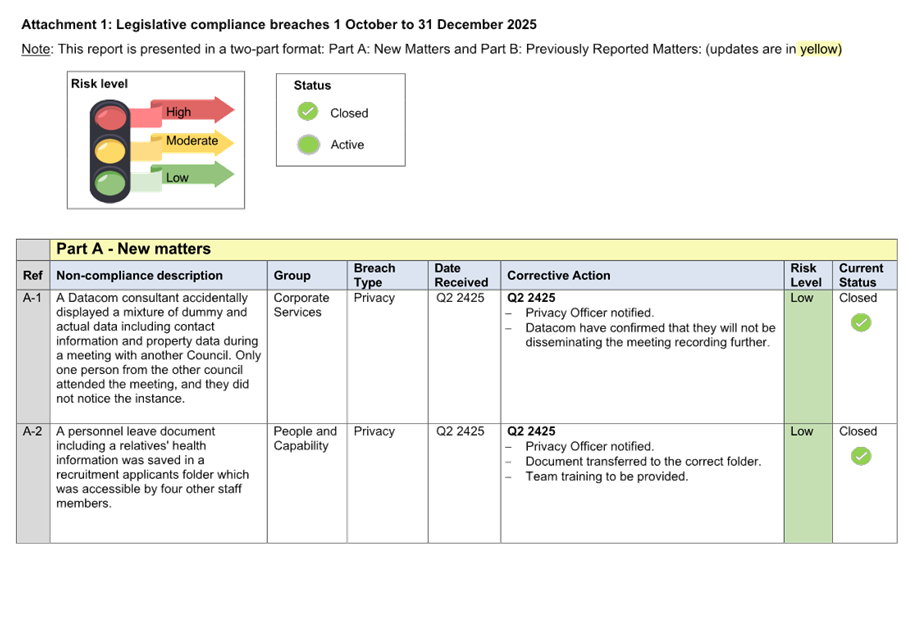
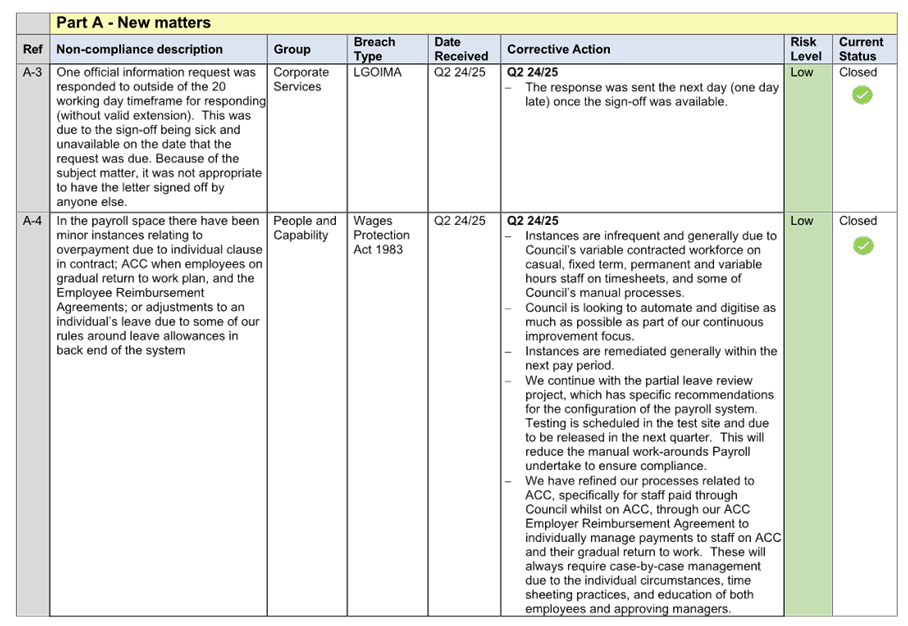
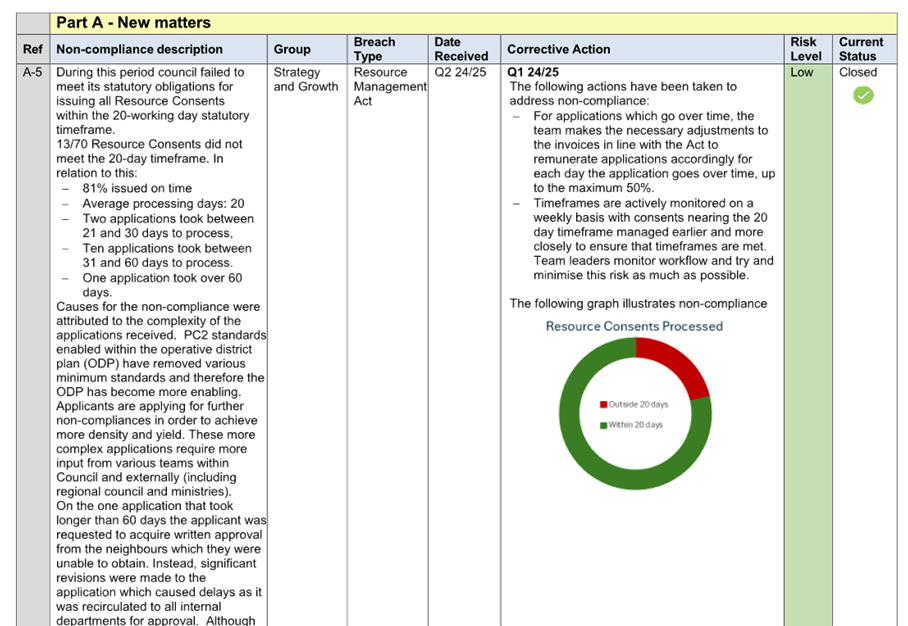
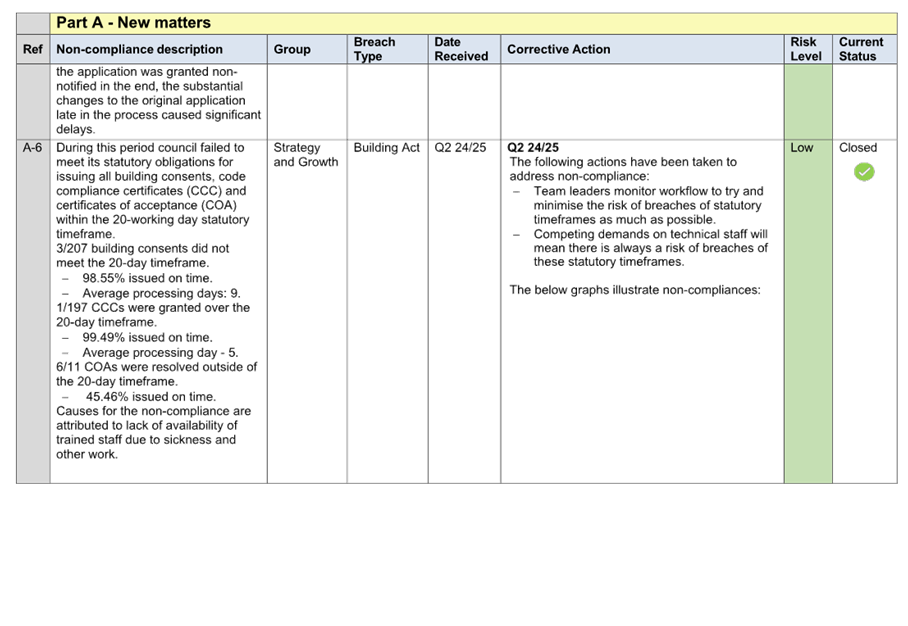
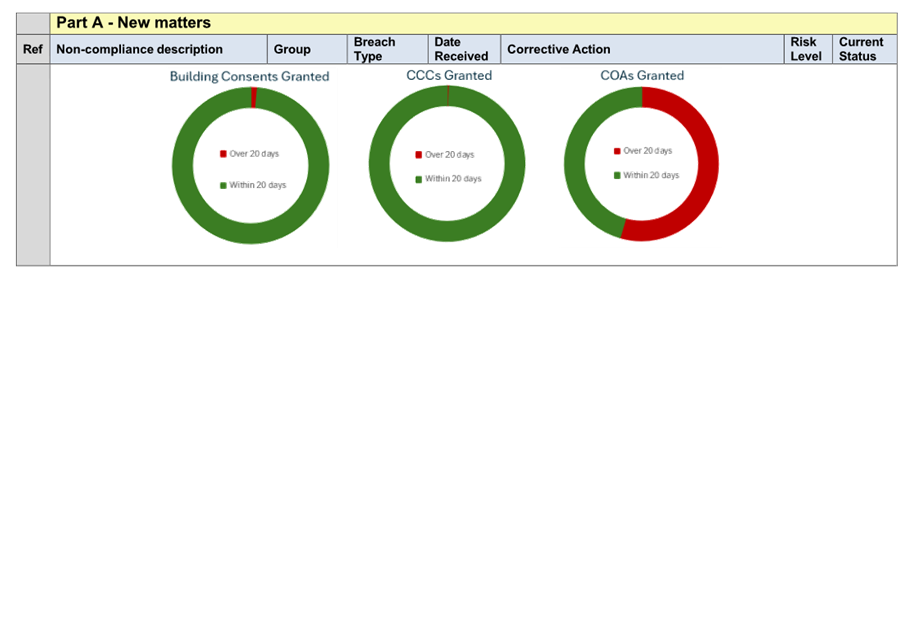
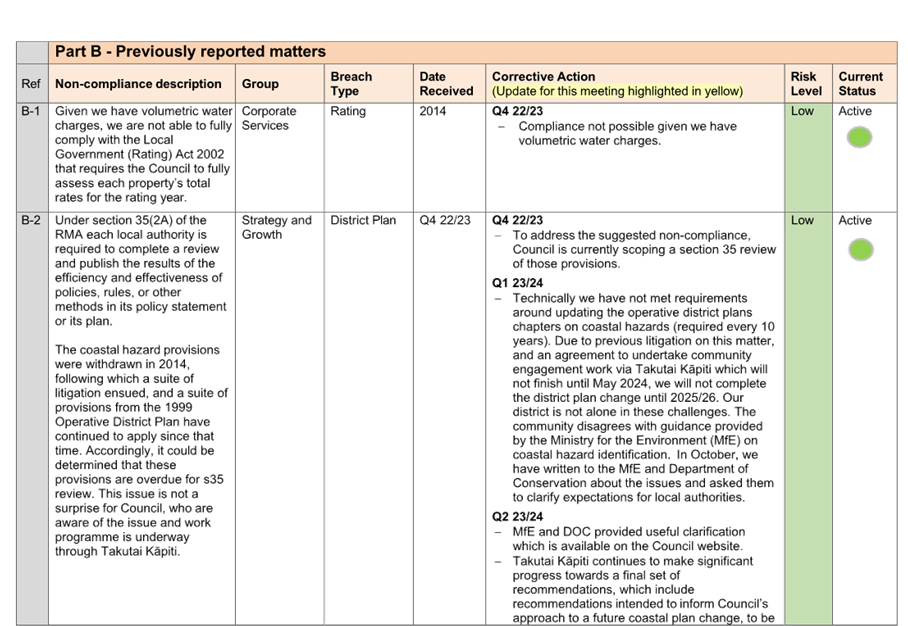
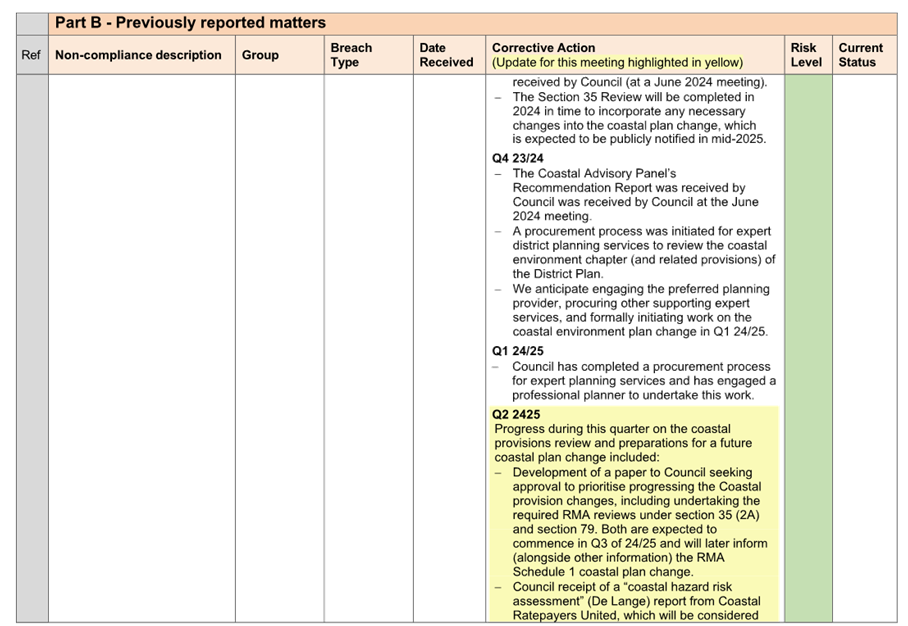

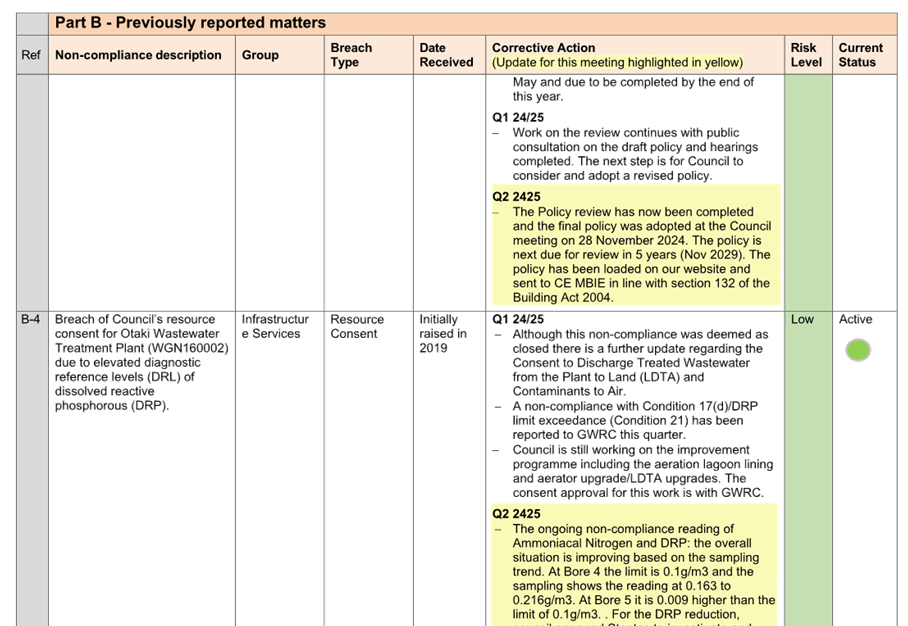
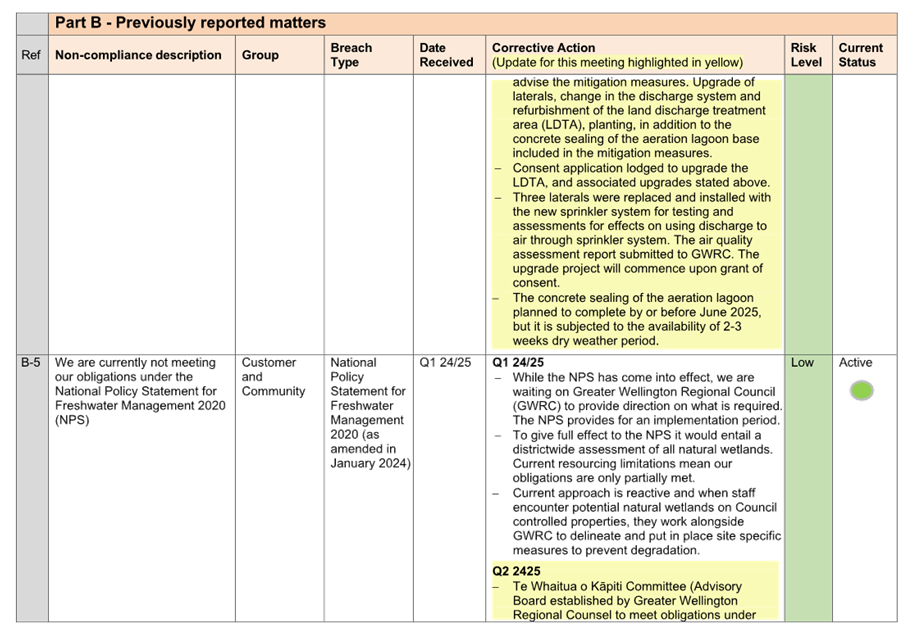
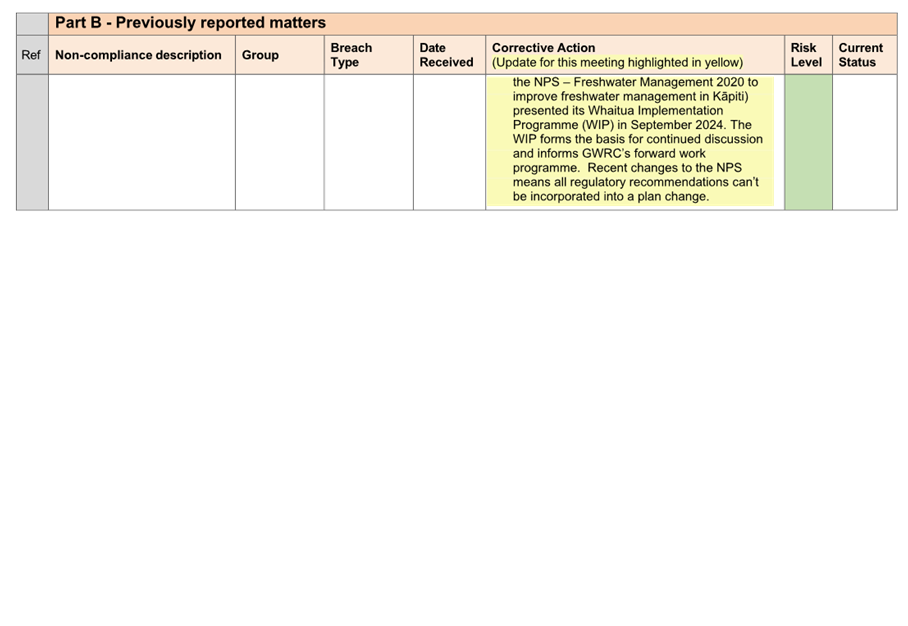
|
Risk and Assurance Committee Meeting Agenda
|
11 March 2025
|
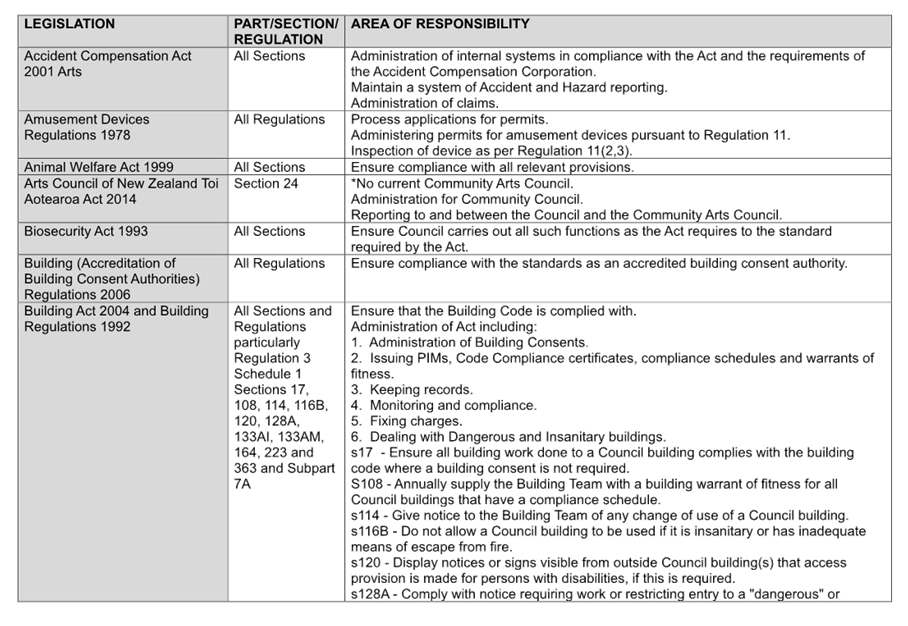
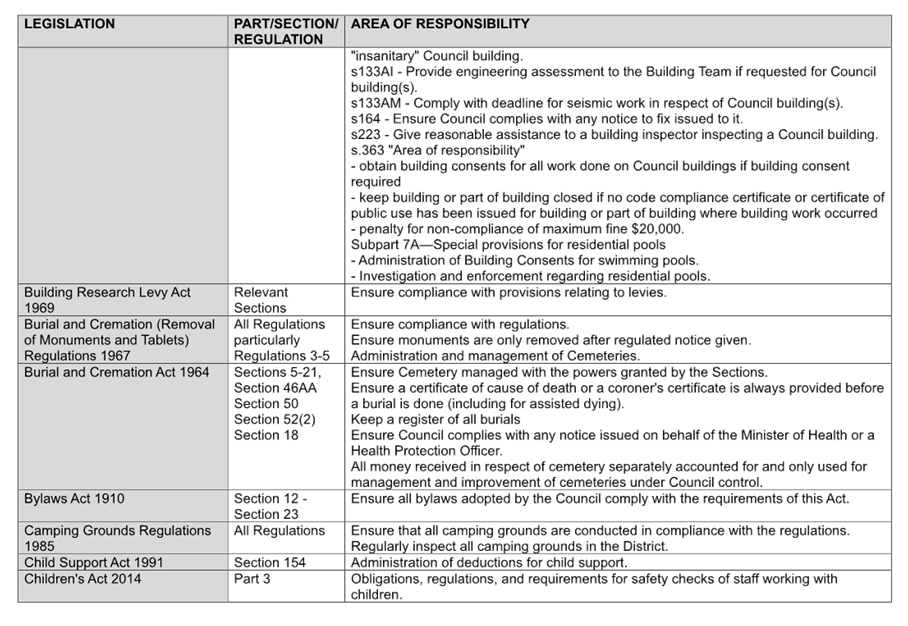
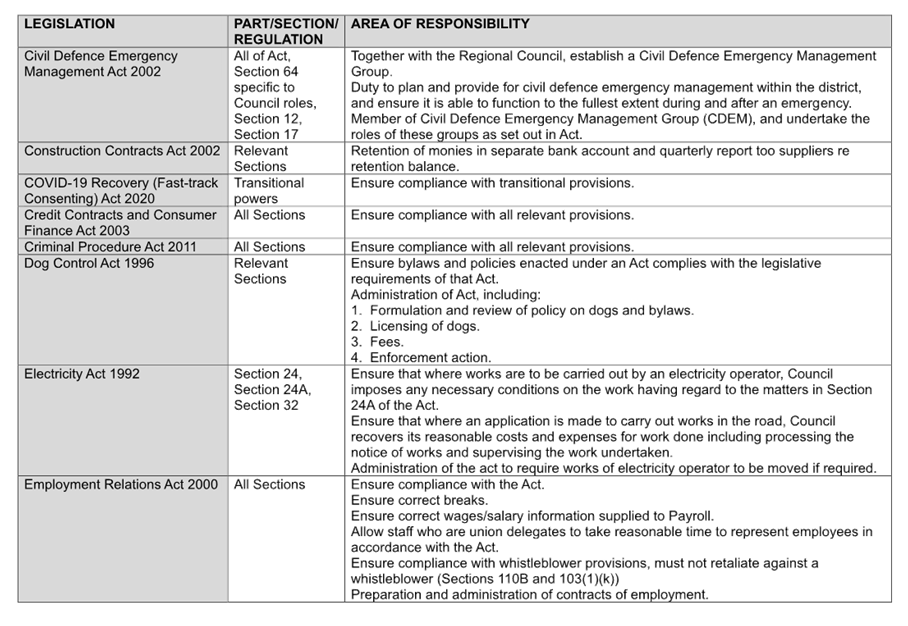
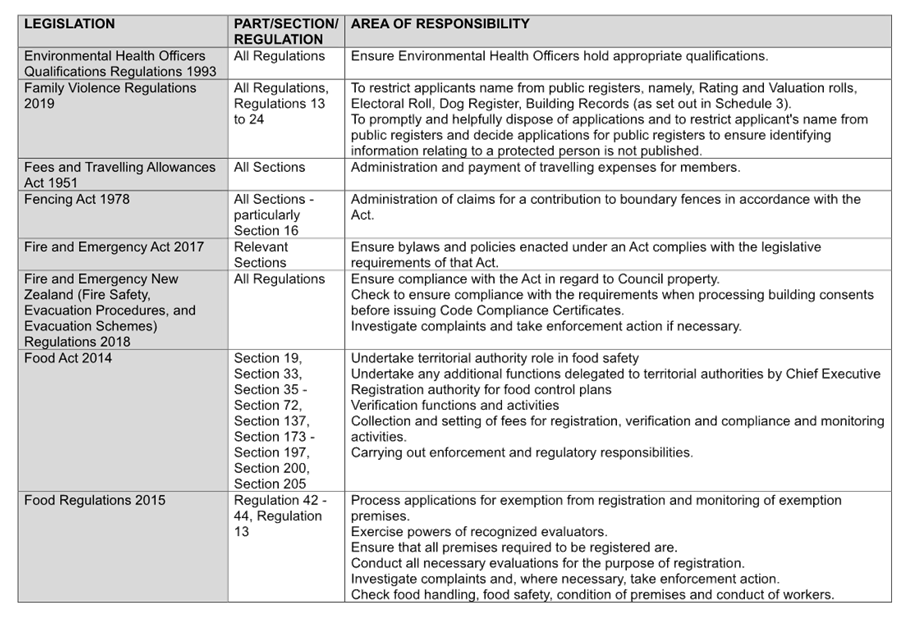
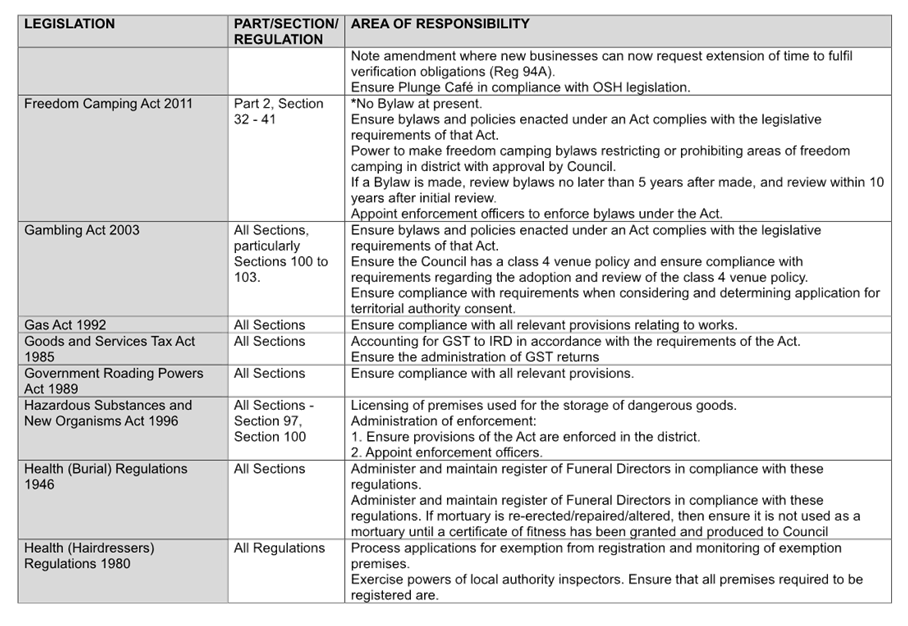
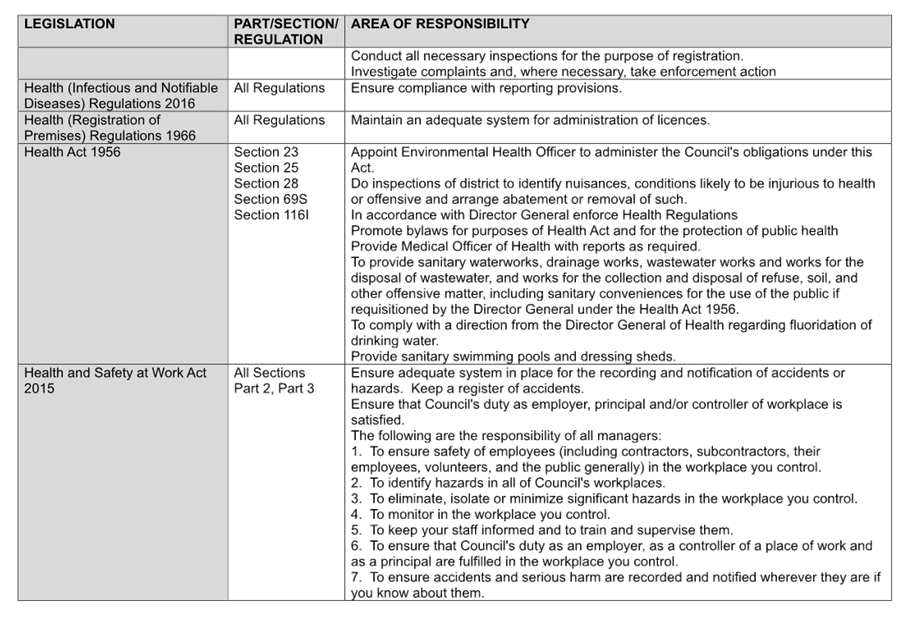
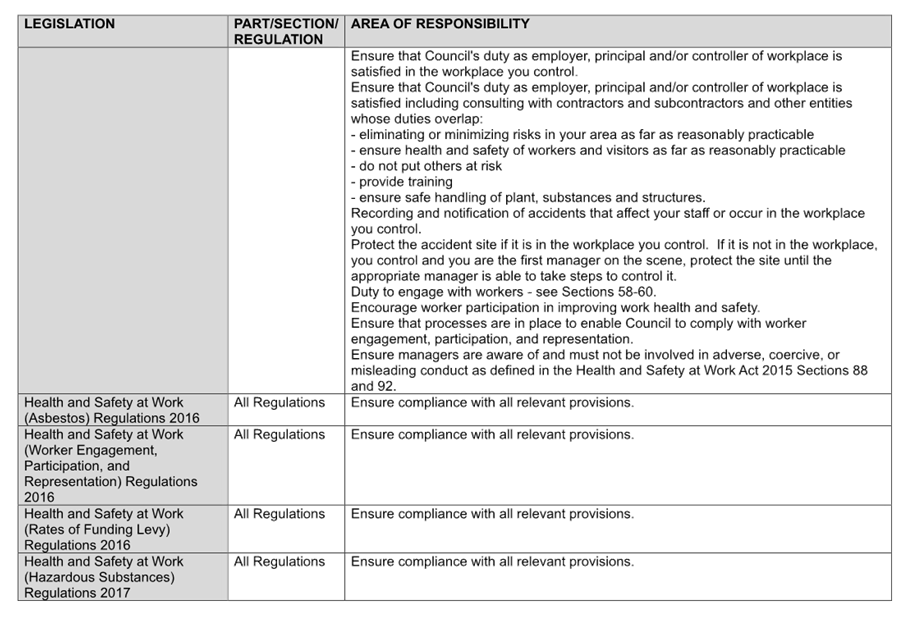
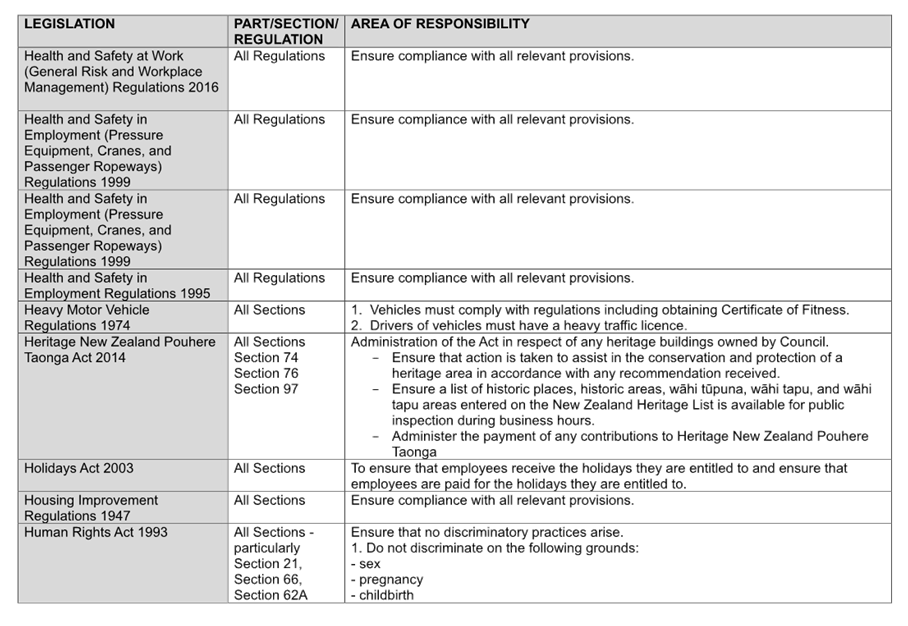
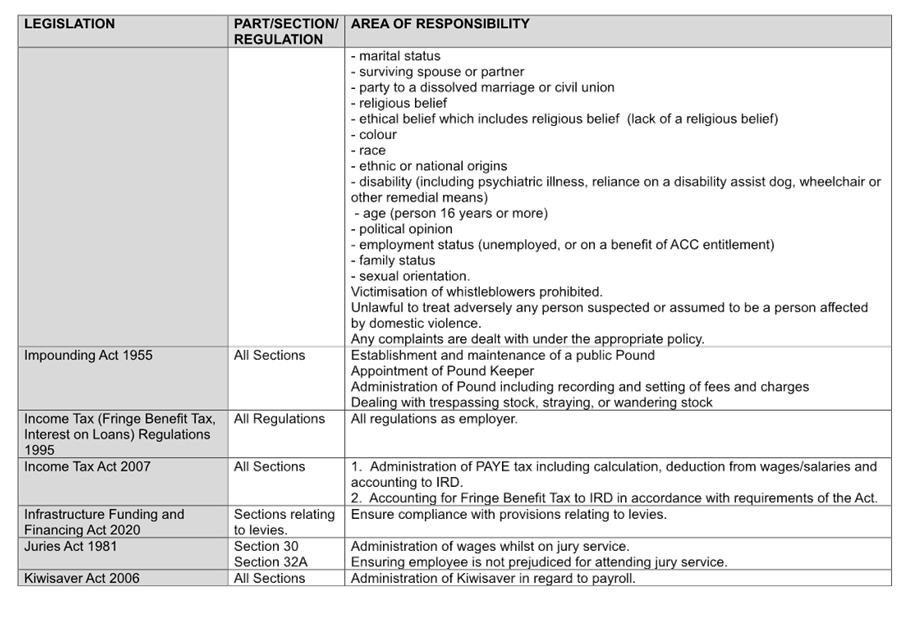
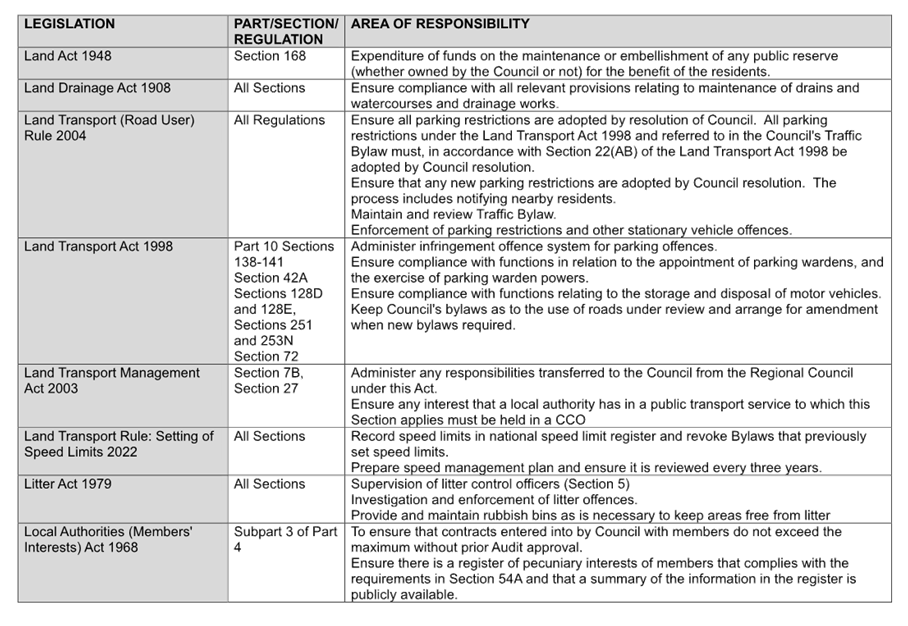
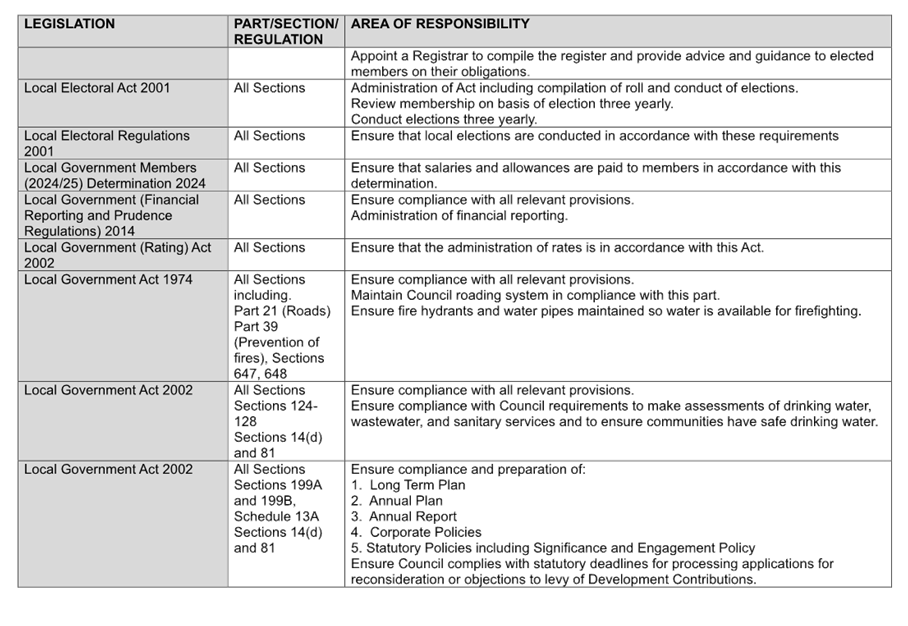
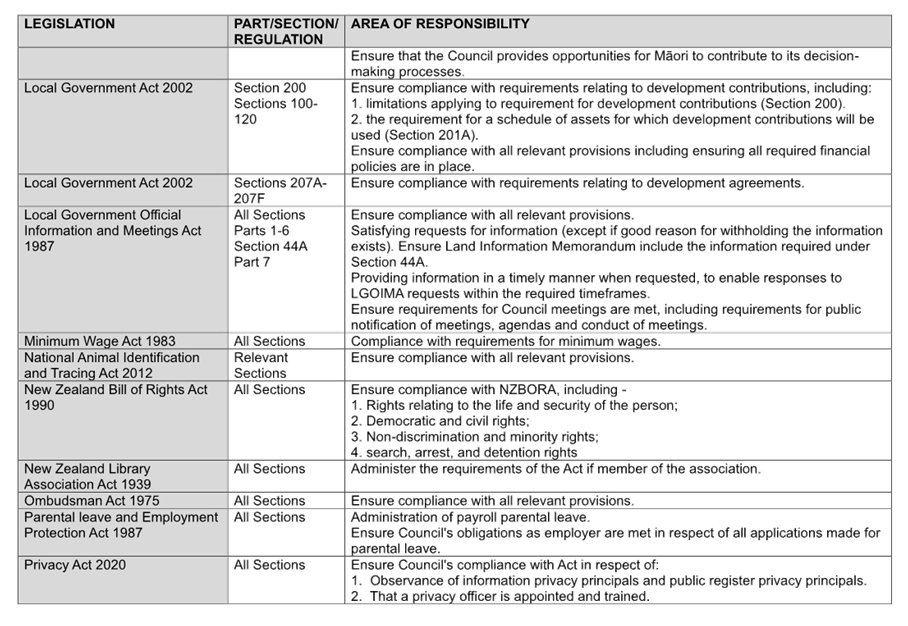
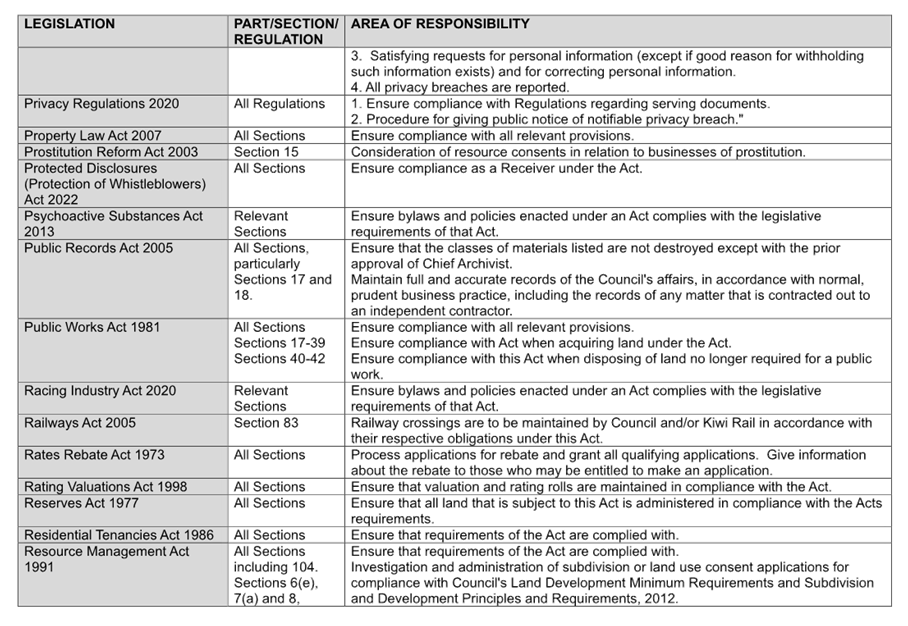
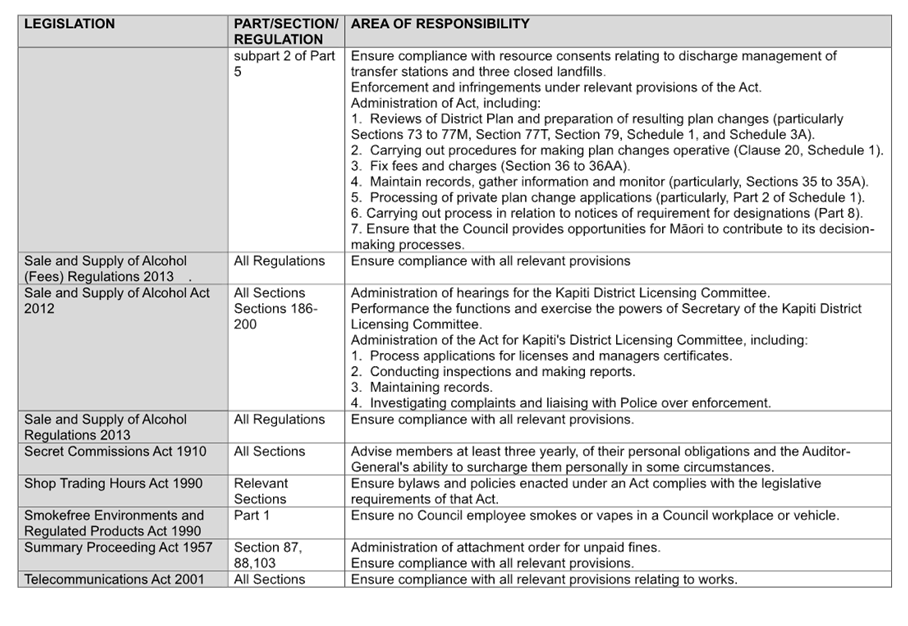
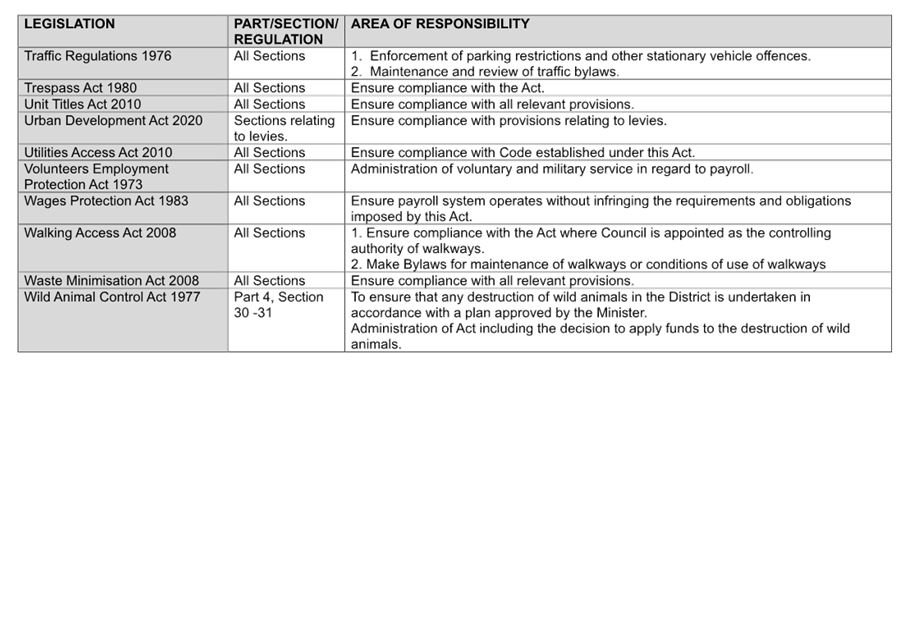
|
Risk and Assurance Committee Meeting Agenda
|
11 March 2025
|
9.7 Quarterly
Treasury Compliance
Kaituhi | Author: Ian
Georgeson, Chief Financial Officer
Kaiwhakamana | Authoriser: Sheryl Gavin, Acting Group Manager Corporate Services
TE PŪTAKE | PURPOSE
1 This
report provides confirmation to the Risk and Assurance Committee of the
Council’s compliance with its Treasury Management Policy (Policy) for the
quarter ended 31 December 2024.
HE WHAKARĀPOPOTO | EXECUTIVE SUMMARY
2 An executive summary is not required for this report.
TE TUKU HAEPAPA | DELEGATION
3 The Risk and Assurance Committee (Committee) has the delegation to
consider this matter under the section
of Part C.3 of the Governance Structure and Delegations 2022-2025 Triennium
which states: “This committee is responsible for monitoring the Council’s financial management,
financial reporting mechanisms and framework, and risk and assurance function,
ensuring the existence of sound internal systems.”
AUNAKITANGA | RECOMMENDATIONS
A. That the Risk and Assurance Committee:
A.1 Receives and notes the “Treasury
Dashboard Report” for the December 2024 Quarter, attached as Appendix 1.
A.2 Notes the Council complied with
all requirements of the Treasury Management Policy for the quarter ended 31
December 2024.
TŪĀPAPA | BACKGROUND
4 As part of the 2024-34
Long-term Plan process the Council adopted an updated Treasury Management Policy,
to apply from July 2024. The objectives of the Policy are to control and manage
borrowing costs, investment returns, liquidity requirements, and risks
associated with treasury management activity.
5 The Council’s
objectives in relation to borrowings are to:
5.1 minimise borrowing costs within approved
risk parameters;
5.2 prudently manage the Council’s
exposure to interest rate changes;
5.3 ensure sufficient levels of liquidity to
meet planned and unforeseen cash requirements;
5.4 ensure
that funding risks are managed by maintaining an appropriate spread of
maturities;
5.5 prudently manage the Council’s
credit exposures; and
5.6 monitor and report on the risk and the
performance of debt portfolios against predetermined limits and benchmarks.
HE KŌRERORERO |
DISCUSSION
6 The
Treasury Dashboard Report for the December 2024 quarter, as at Appendix 1 to
this report, provides an economic overview and reports against Policy
requirements. The dashboard has been developed with Bancorp, our Treasury
advisers, and is in a style consistent with reporting produced for many of their
council clients. We are able to tailor the content to meet any specific
requirements we may have.
7 Policy compliance is
reported as follows:
7.1 Liquidity and funding risk
7.1.1 Overall net debt / revenue within LGFA
covenant 285% (page 8)
7.1.2 Spread of debt maturities (page 3)
7.1.3 Liquidity ratio (page 3)
7.2 Interest rate risk
7.2.1 Total fixed rate hedging and spread across
maturity bands (page 4)
7.3 Credit risk
7.3.1 Counterparty exposure (page 8)
8 The Council complied
with all policy requirements during the quarter.
He take | Issues
9 This
report has a low level of significance under the Council’s Significance
and Engagement Policy).
Ngā
kōwhiringa | Options
10 There are
no options to be considered.
Mana whenua
11 There are
no mana whenua considerations arising directly from this report.
Panonitanga
Āhuarangi me te Taiao | Climate change and Environment
12 There are
no climate change considerations within this report.
Ahumoni
me ngā rawa |
Financial and resourcing
13 There are
no financial and resourcing considerations in addition to those already noted
in this report.
Tūraru
ā-Ture me te Whakahaere |
Legal and Organisational Risk
14 There are
no legal and risk considerations arising from this report.
Ngā pānga
ki ngā kaupapa here | Policy impact
15 There are
no policy considerations in addition to those already noted in this report.
TE WHAKAWHITI KŌRERO ME TE TŪHONO | COMMUNICATIONS &
ENGAGEMENT
Te mahere
tūhono | Engagement planning
16 An
engagement plan is not required for this report.
Whakatairanga | Publicity
17 There are
no publicity considerations arising from this report.
NGĀ ĀPITIHANGA | ATTACHMENTS
1. The
Treasury Dashboard Report for the December 2024 Quarter ⇩ 
|
Risk and Assurance Committee Meeting Agenda
|
11 March 2025
|
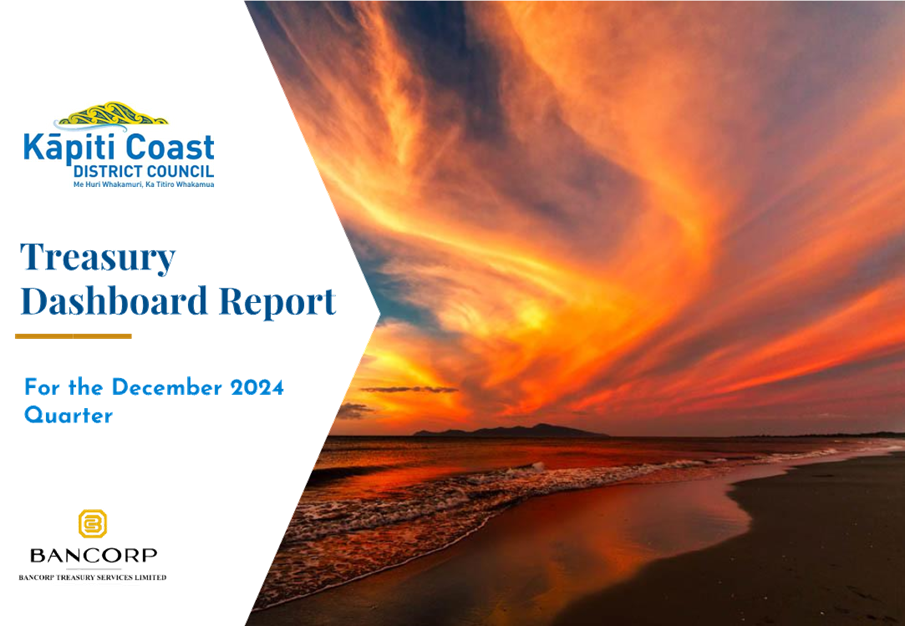
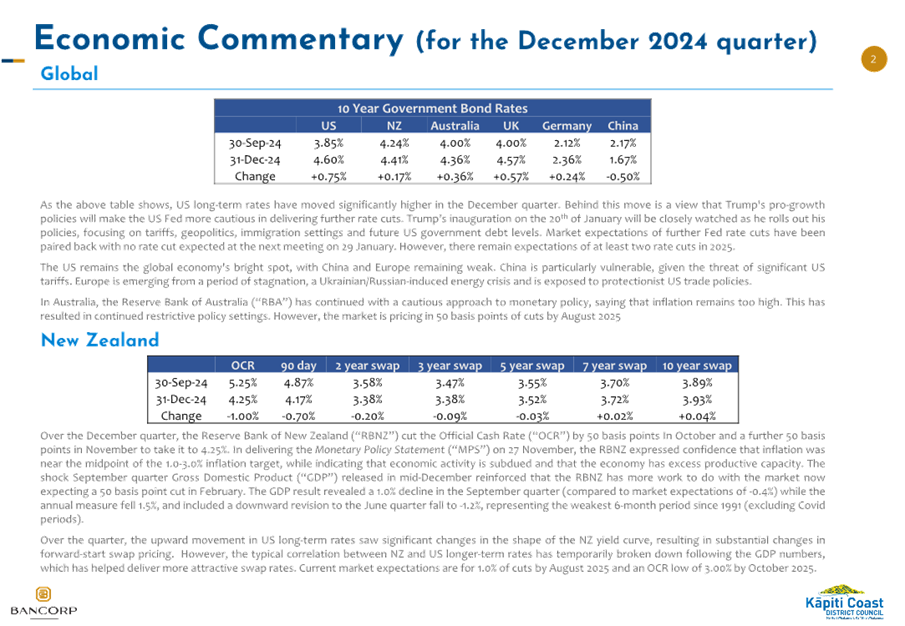
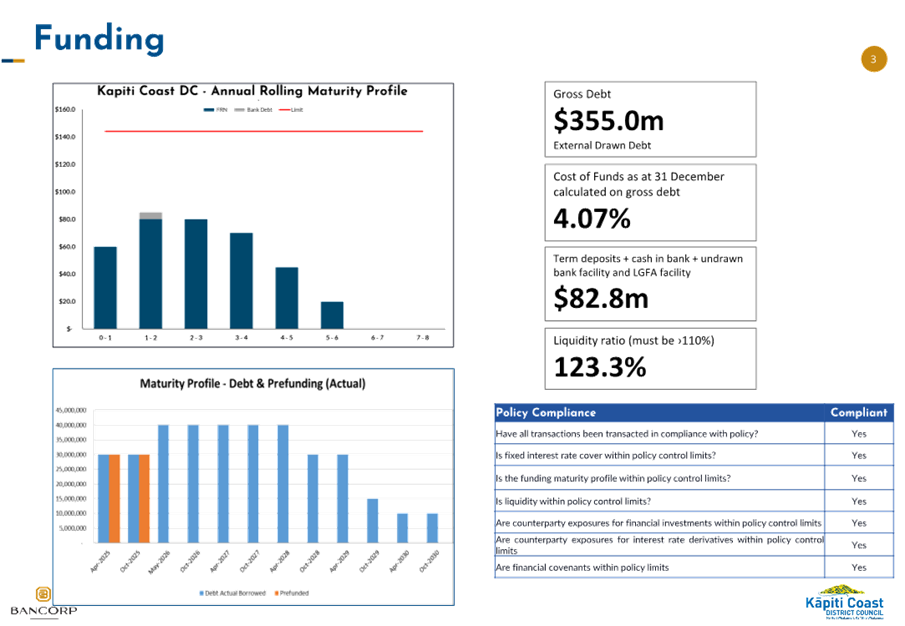
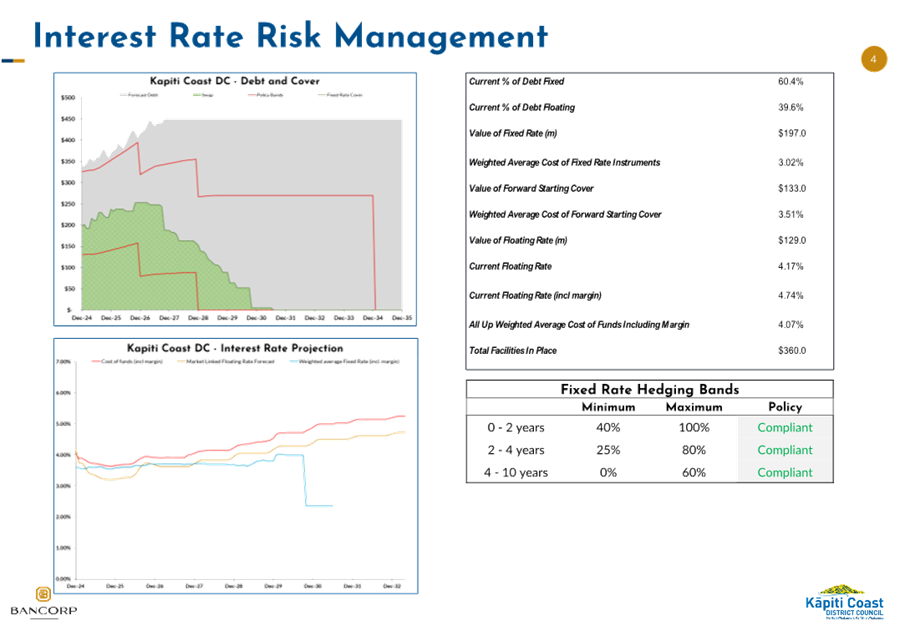
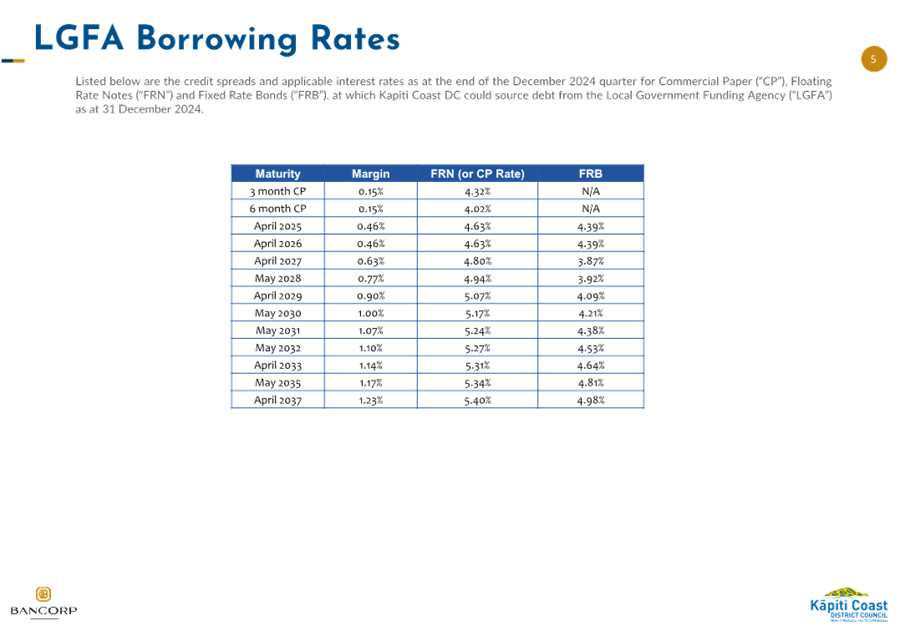
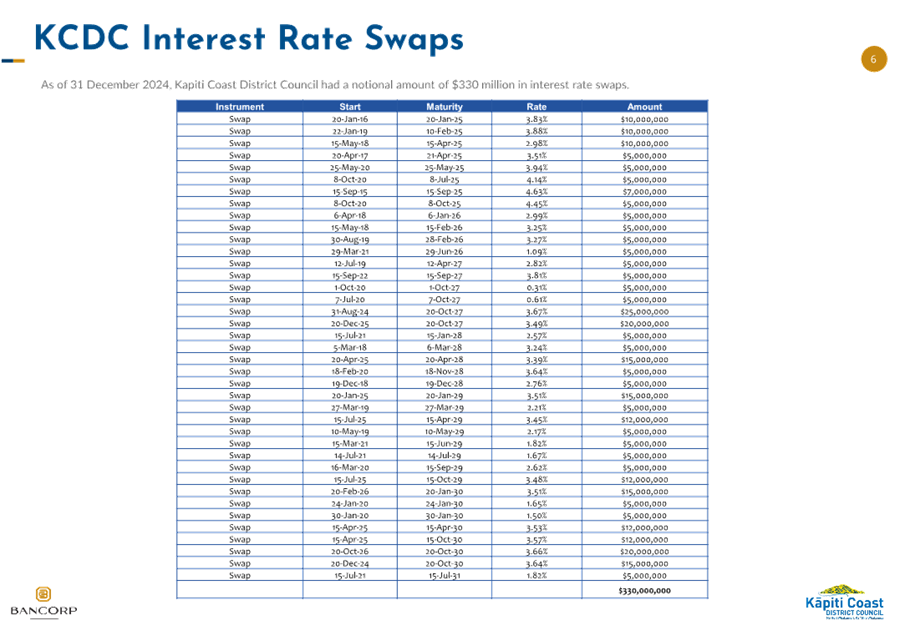
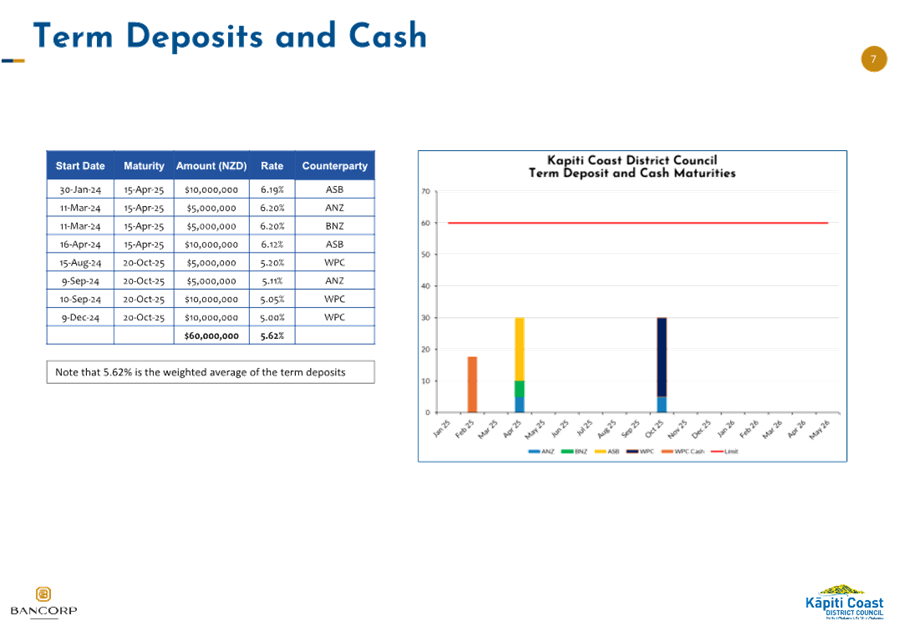
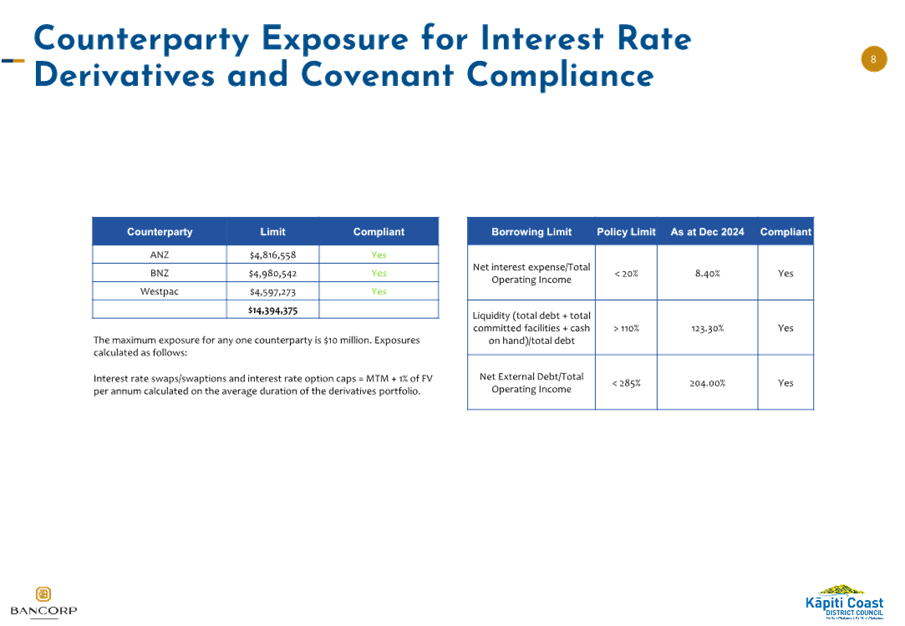
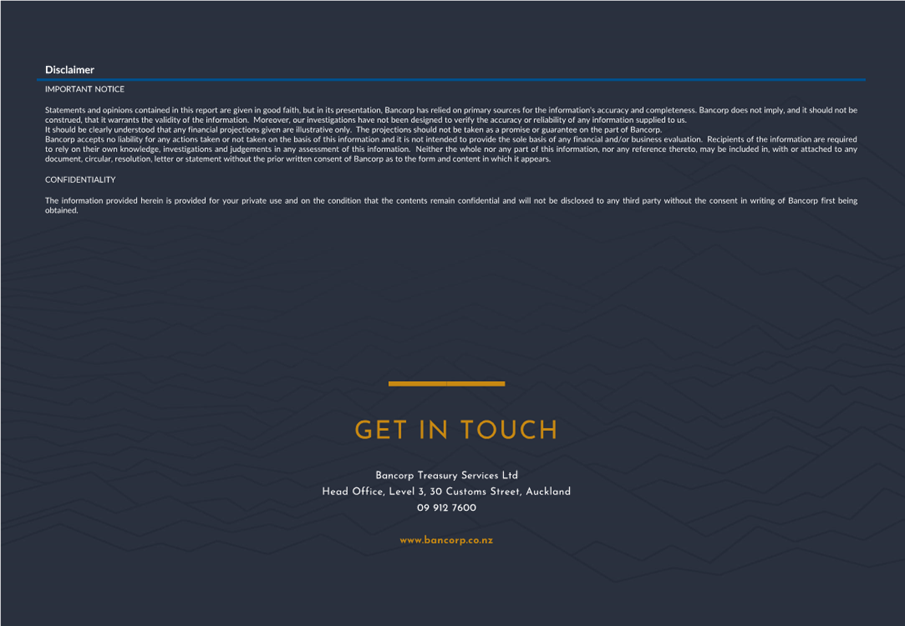
|
Risk and Assurance Committee Meeting Agenda
|
11 March 2025
|
9.8 Forward
Work Programme to September 2025
Kaituhi |
Author: Jayne
Nock, Executive Assistant Group Manager Corporate Services
Kaiwhakamana
| Authoriser: Sheryl Gavin, Acting Group Manager Corporate
Services
Te pūtake |
Purpose
1 This report seeks agreement
to the forward work programme for the Risk and Assurance Committee to September
2025.
He
whakarāpopoto | EXecutive summary
2 An
executive summary is not required for this report.
Te tuku haepapa
| Delegation
3 The
Risk and Assurance Committee (Committee) has the delegation to consider this
matter under the section of Part C.3 of the
Governance Structure and Delegations 2022-2025 and set its annual work
programme which contains matters relating to the committee’s purpose:
“This committee is
responsible for monitoring the
Council’s financial management, financial reporting mechanisms and
framework, and risk and assurance function, ensuring the existence of sound
internal systems.”
Taunakitanga | RECOMMENDATIONS
A. That
the Risk and Assurance Committee approves its Forward Work Programme to
September 2025 as set out in Appendix 1 to this report.
Tūāpapa | Background
4 Under Council’s
Standing Orders, the Chief Executive has the responsibility for approving the
Committee agenda items, this report provides an opportunity for the Committee
to discuss and endorse its work programme going forward which will shape the
items to be discussed at future meetings.
He
kōrerorero | Discussion
5 The forward work programme
for the Risk and Assurance Committee, as developed by the Group Manager
Corporate Services, is attached in Appendix 1 to this report.
6 The work programme includes
those additional items that were requested by the Committee during their last
meeting held in November 2024.
He
take | Issues
7 The establishment and
presentation of the forward work programme is in accordance with the Office of
the Auditor General’s best practice guidance. This approach is used by
other councils throughout New Zealand.
8 That same best practice
also provides for the Committee to review its forward work programme at each
subsequent meeting to ensure it remains relevant and can be adapted as
necessary.
Ngā
kōwhiringa | Options
9 The Committee can consider
and, if necessary, make amendments to the forward work programme attached as
Appendix 1 to this report.
Mana whenua
10 Whilst
this report does not directly affect mana whenua, any such considerations will
be included where appropriate in other reports presented to the Committee as
part of the approved work programme.
Panonitanga Āhuarangi me te Taiao | Climate change
and Environment
11 There
are no climate change considerations for this report.
Ahumoni me ngā rawa | Financial
and resourcing
12 There
are no additional financial considerations for this report.
Tūraru ā-Ture me te Whakahaere
| Legal and Organisational Risk
13 There
are no legal considerations or risks for this report.
Ngā pānga ki ngā kaupapa here | Policy impact
14 There
is no impact on existing Council policies.
TE whakawhiti kōrero me te
tūhono | Communications &
engagement
Te mahere tūhono | Engagement
planning
15 No
engagement planning is required for this report.
Whakatairanga |
Publicity
16 The approved forward work programme
will be publicised through the publication of the agenda and minutes of this
Risk and Assurance meeting.
Ngā āpitihanga | Attachments
1. Forward
Work Programme ⇩ 
|
Risk and Assurance Committee Meeting Agenda
|
11 March 2025
|
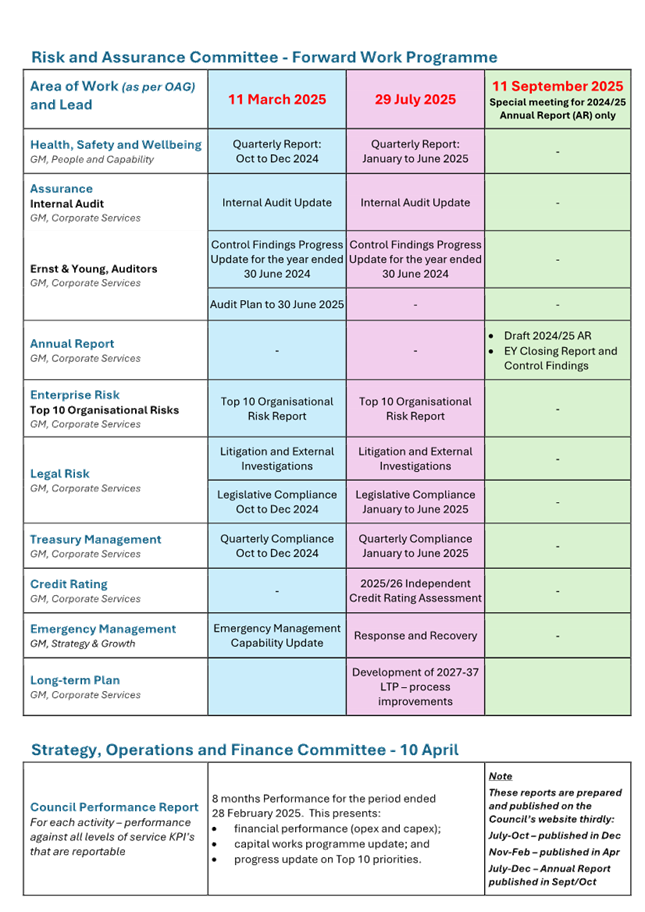
|
Risk and Assurance Committee Meeting Agenda
|
11 March 2025
|
10 Te
Whakaū i ngā Āmiki | Confirmation of Minutes
10.1 Confirmation
of Minutes
Author: Maria
Cameron, Advisor Governance
Authoriser: Mark
de Haast, Group Manager Corporate Services
|
Taunakitanga | Recommendations
That the minutes of the Risk
and Assurance Committee meeting of 21 November 2024 be accepted as a true and
correct record.
|
Ngā
āpitihanga | Attachments
1. Unconfirmed
Minutes of Risk and Assurance Committee Meeting 21 November 2024 ⇩ 
|
Risk and Assurance Committee Meeting Agenda
|
11 March 2025
|
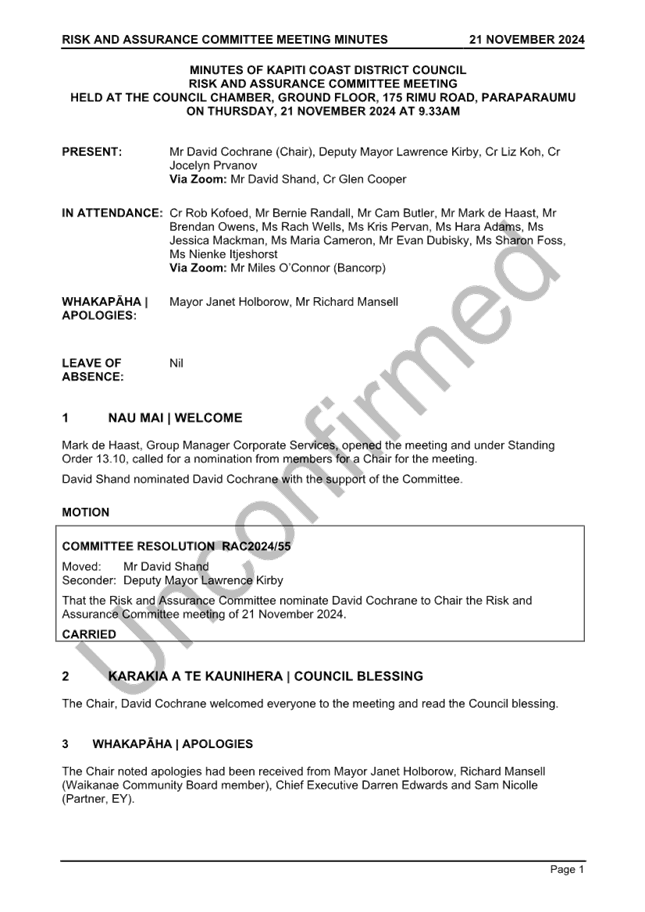
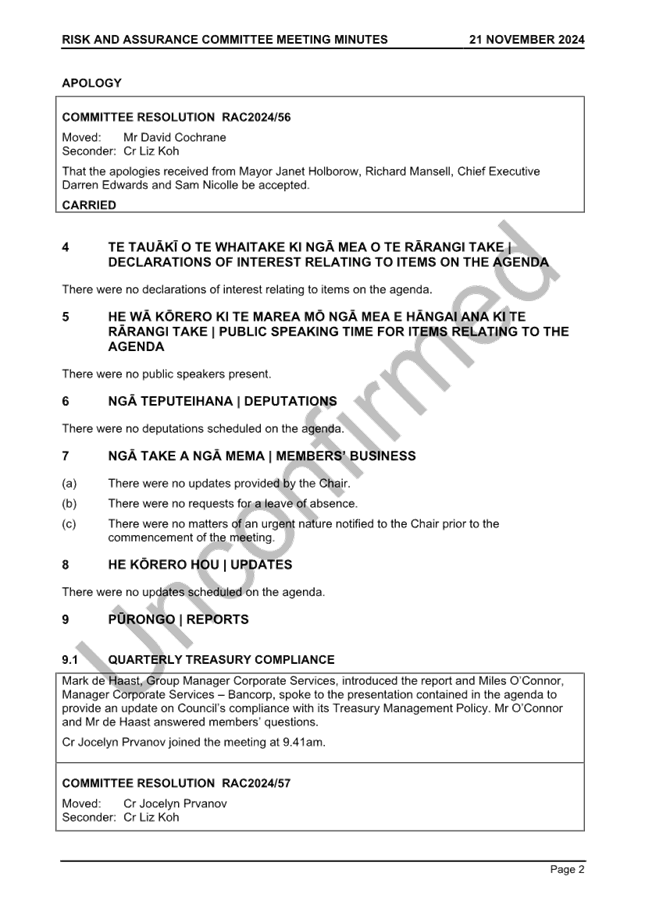
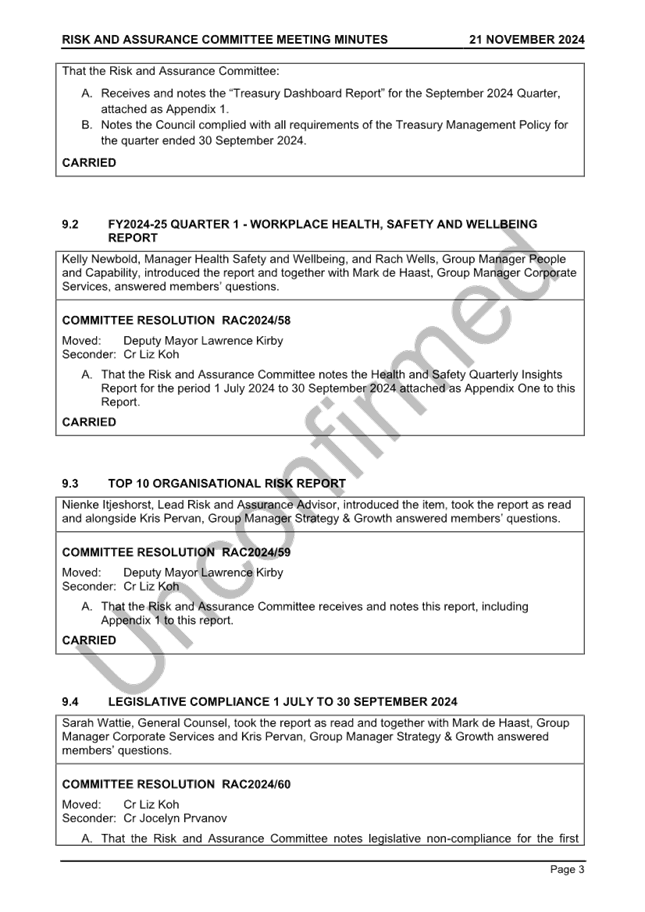
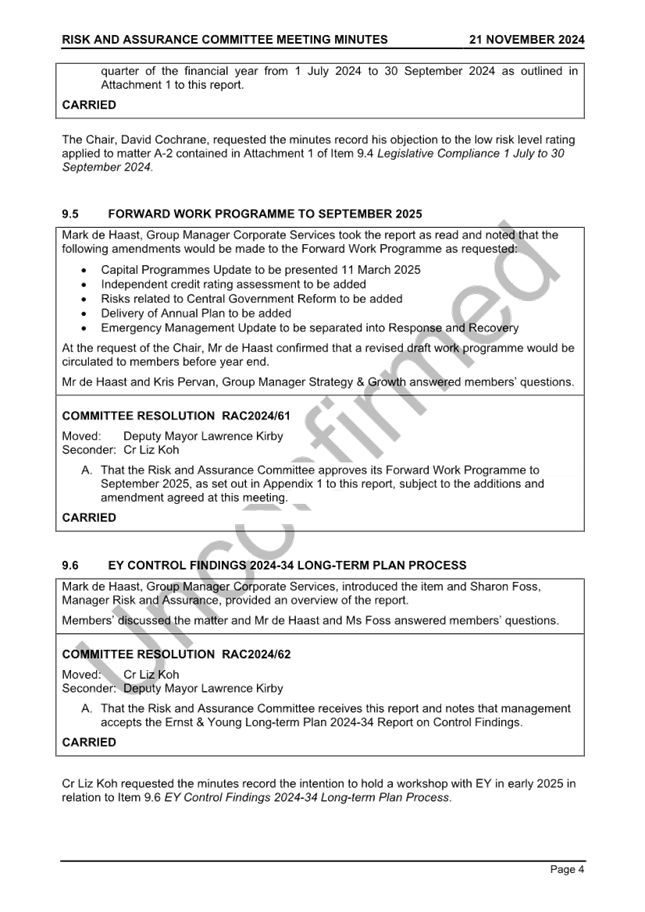
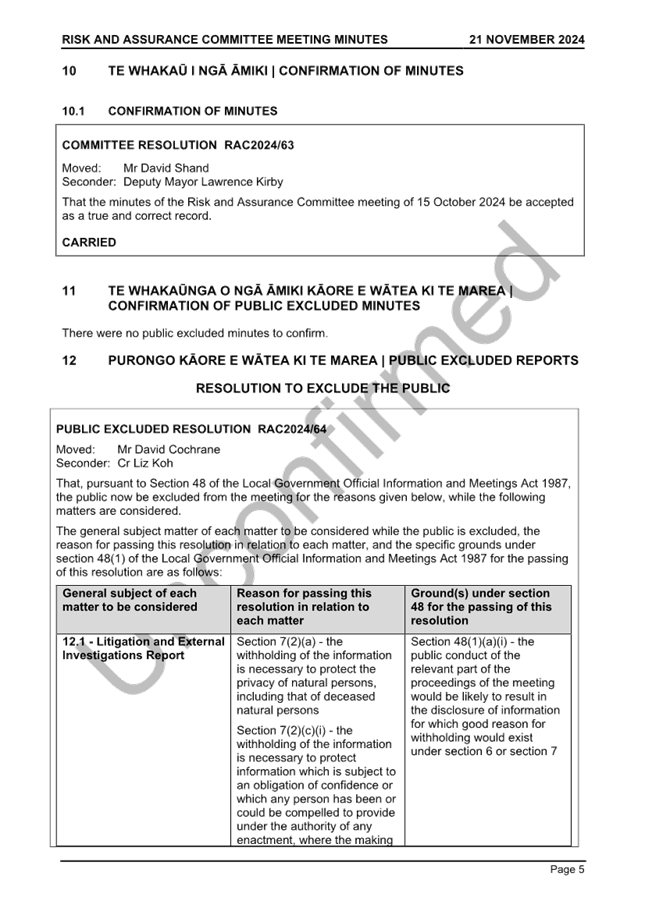
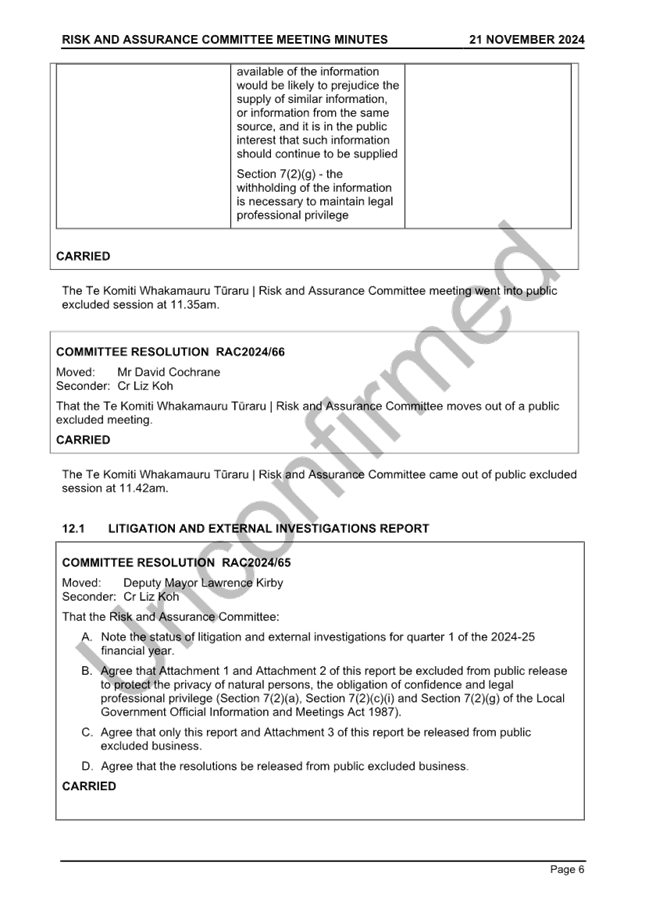
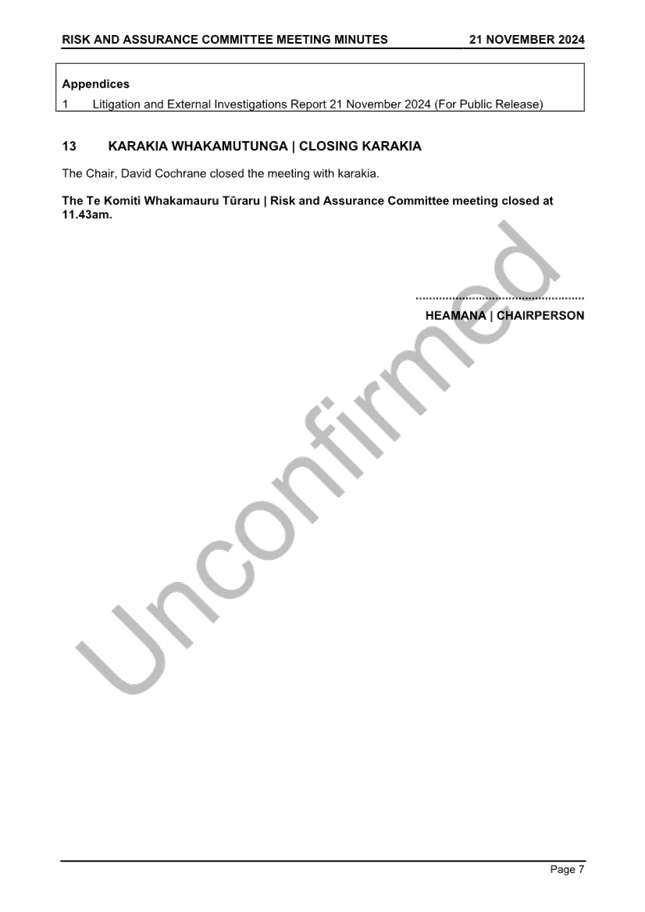
|
Risk and Assurance Committee Meeting Agenda
|
11 March 2025
|
11 Te
Whakaūnga o Ngā Āmiki Kāore e Wātea ki te Marea | Confirmation
of Public Excluded Minutes
12 Purongo
Kāore e Wātea ki te Marea | Public Excluded Reports
Resolution
to Exclude the Public
|
PUBLIC EXCLUDED ReSOLUtion
That, pursuant to Section 48 of the Local Government
Official Information and Meetings Act 1987, the public now be excluded from
the meeting for the reasons given below, while the following matters are
considered.
The general subject matter of each matter to be considered
while the public is excluded, the reason for passing this resolution in
relation to each matter, and the specific grounds under section 48(1) of the
Local Government Official Information and Meetings Act 1987 for the passing
of this resolution are as follows:
|
General subject of each
matter to be considered
|
Reason for passing this
resolution in relation to each matter
|
Ground(s) under section 48
for the passing of this resolution
|
|
11.1 - Confirmation of Public Excluded Minutes
|
Section 7(2)(a) - the withholding of the information is
necessary to protect the privacy of natural persons, including that of
deceased natural persons
Section 7(2)(c)(ii) - the withholding of the information
is necessary to protect information which is subject to an obligation of
confidence or which any person has been or could be compelled to provide
under the authority of any enactment, where the making available of the
information would be likely otherwise to damage the public interest
|
Section 48(1)(a)(i) - the public conduct of the relevant
part of the proceedings of the meeting would be likely to result in the
disclosure of information for which good reason for withholding would exist
under section 6 or section 7
|
|
12.1 - Litigation and External Investigations Report
|
Section 7(2)(a) - the withholding of the information is
necessary to protect the privacy of natural persons, including that of
deceased natural persons
Section 7(2)(c)(i) - the withholding of the information
is necessary to protect information which is subject to an obligation of
confidence or which any person has been or could be compelled to provide
under the authority of any enactment, where the making available of the
information would be likely to prejudice the supply of similar information,
or information from the same source, and it is in the public interest that
such information should continue to be supplied
Section 7(2)(g) - the withholding of the information is
necessary to maintain legal professional privilege
|
Section 48(1)(a)(i) - the public conduct of the relevant
part of the proceedings of the meeting would be likely to result in the
disclosure of information for which good reason for withholding would exist
under section 6 or section 7
|
|
|
Risk and Assurance Committee Meeting Agenda
|
11 March 2025
|
13 Karakia
Whakamutunga | Closing Karakia























































































































